↧
Artist's Statements of the Old Masters (Video) Narrated by John Seed
↧
Ten Rather Eccentric Essays on Art by John Seed: A Video Preview
↧
↧
Can Jerry Saltz Save the Art World and Dan Colen's Pigeons?
In a May 15th report on a recent contemporary art auction held at Phillips, New York, Carol Vogel of the New York Times, noted the following:
![2014-05-19-ScreenShot20140518at8.02.26PM.jpg]()
A screenshot of the auction results for Dan Colen's Untitled, 2006-07
I feel for Carol Vogel who has to report auction results like this one with a straight face. By the way Carol, there were five pigeon shit covered canvases in the lot, not four, so maybe editorial oversight at the NYTimes isn't what it used to be. Is a correction forthcoming?
The real commentary these days happens on blogs and social media sites -- Facebook and Twitter -- where there are no editors to vet content for accuracy and no advertisers (i.e. auction houses or art dealers) who might be offended. I certainly enjoy being able to say what I think about art here on the HuffingtonPost where the advertisers for laser eye-bag removal haven't yet objected to anything I have said.
At any rate, the news of this $545k birddoggle got 49 shares just on my friend's page and when I re-posted it there were some pretty good quips. "Well...it's not bullshit" was one.
The way I understand Colen's "success" is that it is a social phenomenon, not an aesthetic one. For decades now one of the most common accolades given to artists has been that he or she is "pushing boundaries." Never mind that there are almost no boundaries left: if you can find one -- for example, the idea that art shouldn't just be pigeon poop -- then you have a created a binary situation. There are going to be those who are appalled and who shake their head at how awful your art is and there are going to be those that say "Hey, this is amazing." In a 2010 interview Colen spelled this situation out quite clearly:
Jerry Saltz is doing some heroic work on Twitter. Since he understands the social dynamics surrounding art auctions, he has been using sarcasm and ridicule to make his points. For example, here is the tweet he posted after a Colen M&M drawing sold for $65k:
![2014-05-19-ScreenShot20140519at5.06.55AM.png]()
Saltz also called out the "rubes" who paid $320k for a work by art world hot-shot Oscar Murillo:
![2014-05-19-ScreenShot20140519at5.09.01AM.png]()
Jerry, I really appreciate what you are doing: it is heroic and sooner or later the Mugrabis of the world may be cursing you too. I sometimes feel like the art market is a ship that has been taken over by dollar-waving pirates: the same ones who brought us junk bonds and the mortgage meltdown. Their weekend homes are filling up with works by Dan Colen, who just bought himself a farm with his art world loot. I'm imaging it as a kind of factory farm filled with cooing pigeons who are busy right now Pollocking up another suite of masterpieces.
Only your tweets can save them -- and the art world -- from a very dismal future. In the meantime, the spokescandies for M&M say thank you!
A suite of four canvases filled with nothing but pigeon droppings by Dan Colen, another popular American artist, also brought a strong price. David Mugrabi, a New York art dealer, bought the work for $545,000, in the middle of its $400,000 to $600,000 estimate.
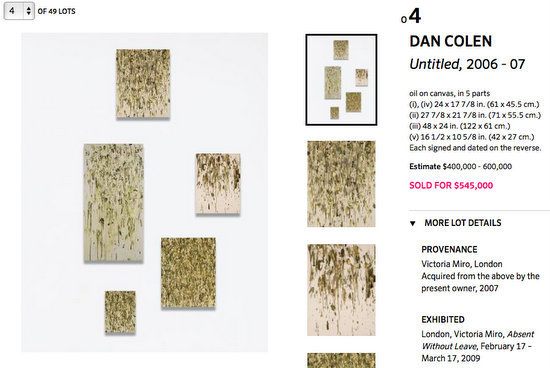
I feel for Carol Vogel who has to report auction results like this one with a straight face. By the way Carol, there were five pigeon shit covered canvases in the lot, not four, so maybe editorial oversight at the NYTimes isn't what it used to be. Is a correction forthcoming?
The real commentary these days happens on blogs and social media sites -- Facebook and Twitter -- where there are no editors to vet content for accuracy and no advertisers (i.e. auction houses or art dealers) who might be offended. I certainly enjoy being able to say what I think about art here on the HuffingtonPost where the advertisers for laser eye-bag removal haven't yet objected to anything I have said.
At any rate, the news of this $545k birddoggle got 49 shares just on my friend's page and when I re-posted it there were some pretty good quips. "Well...it's not bullshit" was one.
The way I understand Colen's "success" is that it is a social phenomenon, not an aesthetic one. For decades now one of the most common accolades given to artists has been that he or she is "pushing boundaries." Never mind that there are almost no boundaries left: if you can find one -- for example, the idea that art shouldn't just be pigeon poop -- then you have a created a binary situation. There are going to be those who are appalled and who shake their head at how awful your art is and there are going to be those that say "Hey, this is amazing." In a 2010 interview Colen spelled this situation out quite clearly:
"It's such a paradox. You come from this place where you want fame; you don't want to be bourgeois, but you want to be successful. You want to be accepted, but you also want to be going against the grain. You want to be on the outside, but you want to be on the inside."Exactly. if your reaction to Colen's "Untitled" is "Ewww... I wonder if his canvases could transmit ocular histoplasmosis?" you are bourgeois. Well, or you are an art restorer worried that you may be called to the Hamptons to re-glue some wayward shit onto one of these next season... The job of art critics is supposed to be to protect us from really bad art, but Robert Hughes has been gone nearly two years now. Alberto Mugrabi -- the brother of David Mugrabi, the dealer who bought Colen's "Untitled" -- told BusinessWeek after Hughes death that "In another year, nobody will talk about this man anymore." The curse doesn't seem to be working among my Facebook friends -- we still talk about Hughes -- and in regards to protecting us from Colen and some of the other artists who are "pushing boundaries"
Jerry Saltz is doing some heroic work on Twitter. Since he understands the social dynamics surrounding art auctions, he has been using sarcasm and ridicule to make his points. For example, here is the tweet he posted after a Colen M&M drawing sold for $65k:
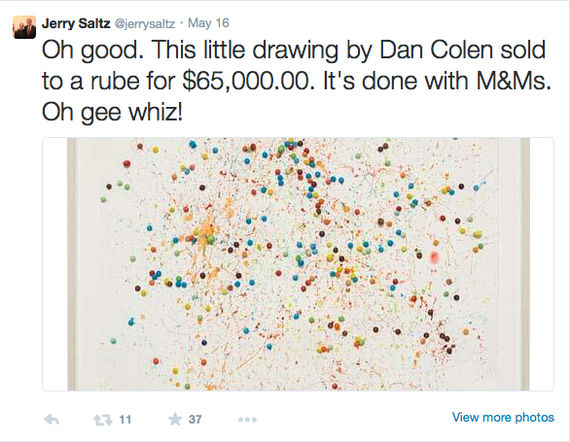
Saltz also called out the "rubes" who paid $320k for a work by art world hot-shot Oscar Murillo:
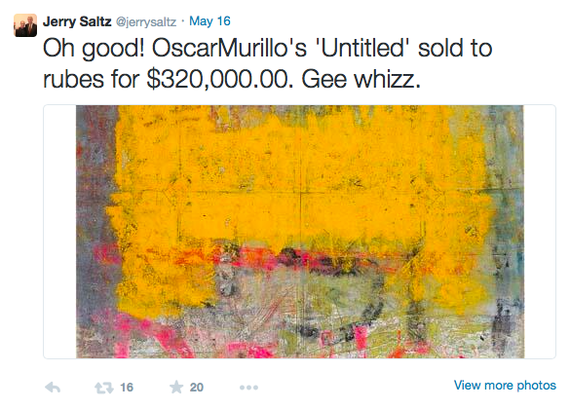
Jerry, I really appreciate what you are doing: it is heroic and sooner or later the Mugrabis of the world may be cursing you too. I sometimes feel like the art market is a ship that has been taken over by dollar-waving pirates: the same ones who brought us junk bonds and the mortgage meltdown. Their weekend homes are filling up with works by Dan Colen, who just bought himself a farm with his art world loot. I'm imaging it as a kind of factory farm filled with cooing pigeons who are busy right now Pollocking up another suite of masterpieces.
Only your tweets can save them -- and the art world -- from a very dismal future. In the meantime, the spokescandies for M&M say thank you!
Correction: After posting this blog it was brought to my attention by Kenny Schacter on Facebook, that Mr. Colen no longer uses actual pigeon shit for this series: he is using oil paint as reported in the Guardian on May 9th. In fact, nobody seems to know if actually Colen or his flocks of assistants ever did actually use real birdshit. He does, however continue to use crack pipes and bubble gum in his work. I stand at least semi-corrected.
↧
Beauty Fierce as Stars*, Groundbreaking Women Painters 1950s and Beyond at Mythos Fine Art & Artifacts
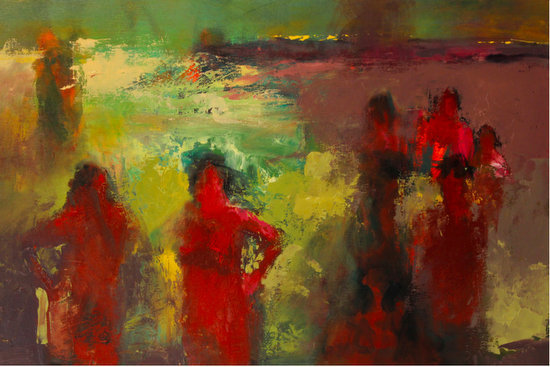
I recently interviewed Karen Zullo Sherr and Sue Steel and asked them about the genesis of the exhibition, and what they have learned as its curators.
Can you tell me: how did this show come about?
Karen: Our last show in January was about the Beat Era, Rebels, Hipsters and Visionaries, Bay Area Poets and Artists 1950's and 60's. We were surprised that there were so few women represented in the work we managed to gather for the show. We also looked at a film about the period and the women were presented as wives, girlfriends and helpers, behind the scenes.
During the events for our show we presented a few films by Mary Kerr, who highlighted a number of women -- besides Joan Brown and Jay De Feo -- working during the period, and we glimpsed some beautiful lyrical painterly abstraction -- the kind of work both of us love -- and so the idea of for the show grew and we decided to track these and other women down.
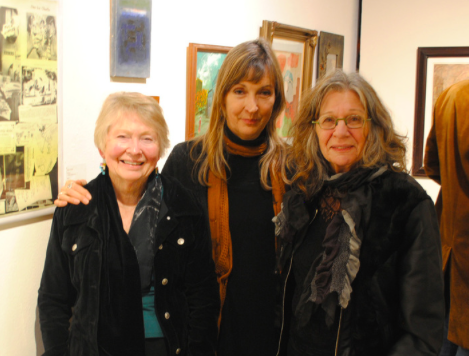
Sue: Another key woman painter, Ariel (Parkinson), who painted during the period, was the inspiration for the original, Mythos Fine Art and Artifacts Gallery. When I first encountered her work, I thought I'd been hit by a force of nature. I started my gallery to showcase her powerful original work.
Eventually Mythos Gallery in its various incarnations began to concentrate on painters and poets of the "San Francisco Renaissance" of the 1950s and 60s (with the help of the Jess Collins Trust and Christopher Wagstaff). There were a few women: Mary Fabilli, Lyn Brockway and Madeline Gleason, who surfaced, but the painters recognized today are largely men. This show is for me a continuation of my interest in the spirit and vitality of these times in the Bay Area, both in painting and poetry.
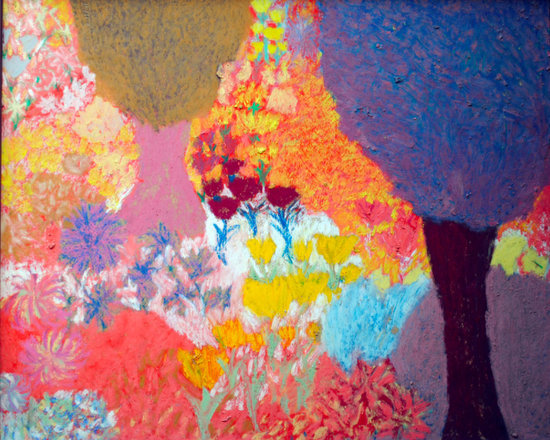
Karen: There were a lot of constraints on women because of the culture of the 50s. And so I think their were not many opportunities for them to show their work and gain exposure and then experience all the give and take that comes with that process. It was hard for them to be taken seriously and also to present themselves as serious artists.
We will be showing a couple of films of New York artists Grace Hartigan and Joan Mitchell, and although prominent now, they struggled to be shown and considered as good as the men. They talk about it eloquently in these films.
One of the artists we visited to pick up work was married to a very well known painter of the period and said "I don't want to complain, never want to complain about what happened to me." She was talking about feeling overlooked at the time. But it is still hard for people who were raised during that time period to confront that.
Sue: Some of the women artists, remained in the background because they believed that was their role and some discontinued their careers to raise families, such as Lyn Brockway.
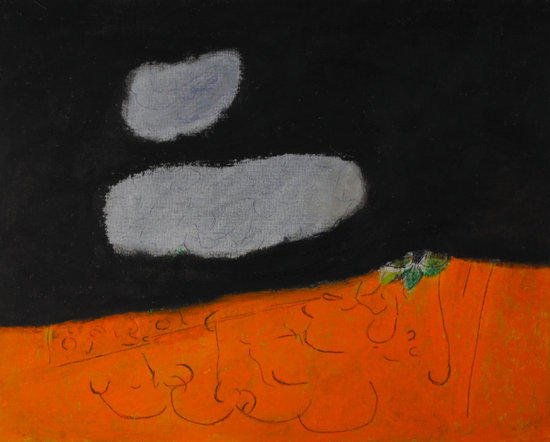
Karen: I would not use the word discoveries because most of the women in the show have exhibited their work over the years quite a lot. But in terms of a few women I had never even heard about we are very impressed with the rich abstractions of both Ann Morency and Lynn Faus. I had known Bernice Bing (Bingo), so I was aware of her work, and the examples we have in the show are light-filled and radiant. After her death supporters have campaigned to have her work viewed more widely and that should continue.
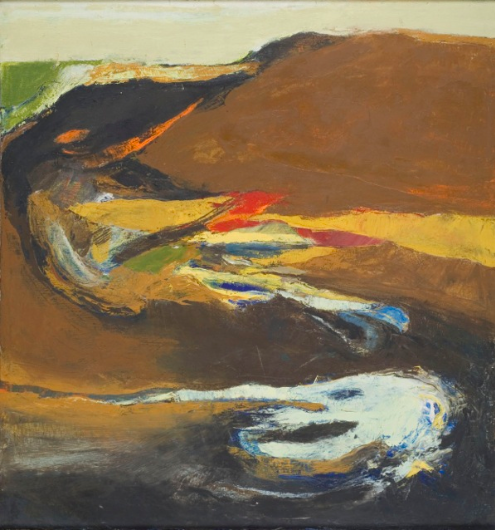
A personal discovery of mine I guess is the work of Adelie Landis. I have know of her of course, but seeing more of her work I see how strong her old and her newer abstract is and we hope to show more of her work. We also want to show more of June Felter's more typical work in the next show.
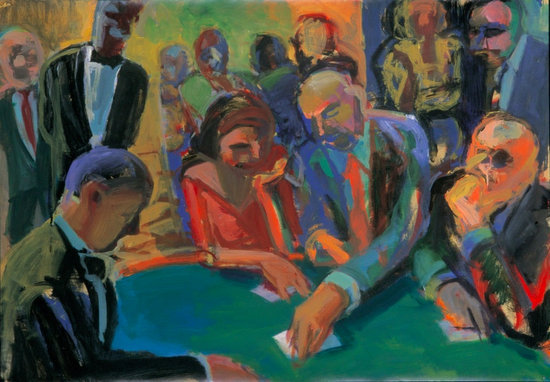
Karen: We have been pleased with the response. After we got it hung and had a chance to relax we thought the show beautiful and very rich. That is the response we are getting from viewers too, both from people who know about the period and others too who are not aware of the history. Many people have commented on the brilliant color and strong emotional impact of these highly charged paintings and say that the current art scene rarely seems to yield such intense passionate work.
Sue: We feel heartened to bring back together several generations of women painters, many of whom were colleagues at the San Francisco Art Institute, to celebrate their work and bring them more recognition for their wonderful creations and to encourage an interest in a fascinating explosive period of art, which continues to influence young painters today.
Featured Artists: Ariel, Bernice Bing, Adelie Landis Bischoff, Nell Blaine, Lyn Brockway, Lisa Esherick, Mary Fabilli, Lynn Faus, June Felter, Lilly Fenichel, Lin Fischer, Deanna Forbes, Jane Freilicher, Sonia Gechtoff, Ann Morency, Ursula O'Farrell, Mary Lovelace O'Neal, and Deborah Remington.
May 9 - June 21
Mythos Fine Art and Artifacts at Firehouse North
1790 Shattuck Avenue Berkeley, CA
↧
In Memoriam: Conrad Mecheski (1968-2014)
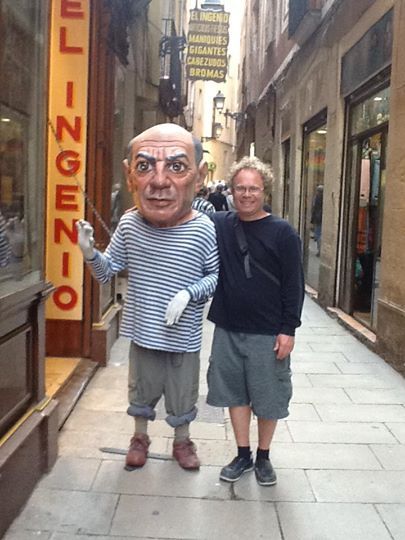
- Ralph Waldo Emerson
Conrad Mecheski, who passed away in early May from cancer, was an artist who had a very pure sense of the role that art should play in his life.
Born in Northern Ireland, Conrad attended high school in Vienna, Austria and then studied at the Art Institute of Boston. After 1991 he spent a number of years in the Kensington neighborhood of San Diego, living simply in a small apartment filled with paintings and exhibiting his vividly colored canvasses at local galleries. More recently he had moved to Florida where he faced his final illness.
Although his work was most often called Expressionist, Mecheski was very much an individual, and the appearance of his work varied considerably over time. At one point Mecheski had wanted to be a writer, and his art often incorporated written commentaries. His imagery wandered freely between art historical references, fantasy and reality. Mecheski's work had a wide emotional range: it could be sentimental, erotic, angry, inventive, lovely or flat-out silly. He worked in a variety of media including drawing, painting on paper and canvas, and iPad. He also made polychromed sculptures and loopy pen doodles.
"When he woke up in the morning he had nothing in mind," explains his wife Mia Aguilar. "He would have his banana, set up and put paint on paper. He had no preconceived notions about how the painting would unfold." One of Mecheski's short artist's statements also emphasizes his dedication to art as a form of exploration:
Many people have given me advice and have tried to fix me. It is difficult for a human to just be. That is what I can try to do. Just be. We don't need to give each other anything. To just be with each other is enough. There is peace in that. We don't know what will happen, we never have known. That is why I love to paint so much, because I love the mystery of not knowing the outcome of the painting. I don't know the outcome of my life. Never did, never will. It remains a mystery. It is exciting up to the end.Mecheski was in many ways a rather private man who preferred to be in touch with a few close friends, but the paintings he posted on Facebook in his last months were in essence public statements that allowed a wider group of friends and acquaintances into his life. Along with posting paintings he also posted his personal musings:
To be misunderstood is fantastic. There was a time when I painted to be understood. Then I realized it was limited. This is not something i try to do. It happens, It's misunderstood.Although most of the paintings Mecheski created during his hospitalization were imaginative fantasies filled with invented characters, one of his final paintings included all the members of his immediate family.
Mia and Conrad married on May 2, the day before he passed away.
↧
↧
A Children’s Tour of the Metropolitan Museum: 2034
↧
April Nordbee: Small Town Duchamp
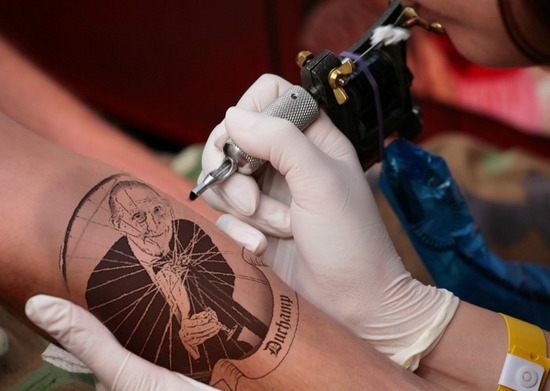
April Nordbee, a 29 year old mother of two who lives in Swedborg Falls, Wisconsin, has found her life completely changed over the past two years, all as the result of a lucky keystroke error she made during a Google search that caused her to discover the life and work of artist Marcel Duchamp (1887-1968). Nordbee's subsequent transformation from an LVN into a nationally recognized conceptual artist has both shocked and electrified the rust belt town of 35,000 where she grew up. "April certainly has shaken us up," says Roger Ballens, the town's mayor, "but she has also put us on the map and given the local economy a real shot in the arm."
"I was doing a search for duck stamp," Nordbee explains, "and I had just typed the 'c' in duck on my computer when my four year old Kevin slammed his T-Rex onto the keyboard to get my attention and BOOM up comes Marcel Duchamp on Wikipedia. After putting Kevin on his Elmo chair for a time out, I started to read about Duchamp -- Why not? I thought -- and when I saw the picture of his bottle rack I literally got goose bumps. It was like Duchamp was speaking to me personally, telling me 'Anything can be art and anyone can be an artist.'"
It was the first time Nordbee had ever heard of Duchamp -- a revolutionary modern artist who is considered the grandfather of Conceptualism -- but her interest in art wasn't anything new. Always good at drawing, a colored pencil sketch she made of a unicorn in 8th grade had earned her a second prize ribbon at a local fair, and Nordbee says that she would have either attended beauty school or art school had she not become pregnant with Cody, her oldest boy, who arrived just after high school graduation.
The years that followed graduation weren't easy ones: April and her sweetheart-turned-husband Ed had to move in with his parents while Ed learned welding at a local trade school. After baby Kevin arrived a few years later April was able to get her nursing degree by attending night classes, and the couple had been able to move to their own apartment just before Ed was laid off. "Things had just started looking up for us when Ed lost his job," Nordbee recalls, "and we didn't want to fall back on our parents again. If I hadn't discovered Marcel I don't know what we would have done."
"On the day that I accidentally googled Duchamp Ed was out earning some cash doing landscaping work. My head was just literally swimming thinking about Duchamp and I wanted to find a way that Ed could share in my excitement when he came home. I called my mother, who came and took the boys to her place for a sleepover, and then I got busy quickly. I put some chicken in the crockpot, turned Kevin's tricycle upside down in front of the fireplace and lit the fire.
When Ed came home he found me buck naked sitting at a chessboard with the wheel of Kevin's tricycle spinning gently behind me. I handed him a joint and said to him: 'I need to tell you all about the work of Marcel Duchamp.' I had been thinking about how to explain Duchamp to him, but he got it right away. He knows that all the manufacturing is going to China and when I told him being an artist means just signing things and becoming famous he was right on board with it. After I made a pledge to him -- 'neither of us will ever have a real job again'-- we made love on the floor next to the chessboard. It was the most beautiful night of our lives."
The next day Nordbee quit her job at a local manor care facility and had an image of Duchamp tattooed on her left arm. The bold tattoo, which showed Duchamp behind his famous "Bicycle Wheel" was her way of letting her family and friends know that she was a new person now: an artist who was re-making her life to reflect the art and ideas of a dead Frenchman they had never heard of.
Two weeks later Nordbee entered her first readymade -- simply titled 'Blender' -- in the annual juried show of the Swedborg Falls Art League. Although her piece was rejected by the exhibition committee Nordbee signed the work 'A. Nordbee' with a black sharpie and made free margaritas in it outside the local Kiwanis Hall during the opening night of the art league show, drawing quite a crowd. She also handed out over 200 postcards -- purchased earlier in the day at a local Christian bookstore -- each featuring a printed image of Jesus. Nordbee had altered each card by adding a touch of lipstick to Christ's lips with a red pastel and penciling the words 'He's got a hot ass' on the card's lower edge. When a brief story about Nordbee and the altered Jesus cards appeared in the Milwaukee Patch the next day, the blog went viral and comments had to be disabled.
"When Pastor Raines called the next day he was very angry about the Christ card," Nordbee reflects. "I stayed calm and told him that I still loved Jesus, but that Duchamp had shown me that you aren't going to get any attention for your work if you don't take a shot at some famous person or symbol or at least sex them up a bit. Besides, I know for a fact that his church was totally packed when he did a sermon about my piece the following Sunday: he actually e-mailed me to say thank you."
As a result of the Patch story, Nordbee also began to hear from a lot of out-of-towners, including a curator from the Milwaukee Art Museum and another from the Dia Art Foundation in New York. "I didn't know what a curator was at first, but I got that sorted out pretty quickly" Nordbee states. "They were very, very interested in me and the curator from the Dia told me that I was as a woman artist re-doing a man's art career I was a really big deal and that I could get grants."
A month later she was in the news again with a large-scale event called 'In Advance of Corporate Downsizing' that took place at an abandoned air conditioner plant. "Duchamp understood that artists and viewers are both participants in whatever the art is," Nordbee comments, "So I knew I had to go all out to show everyone a good time. My sister and I made an installation by hanging all the old broken equipment and tools we could find from the ceiling with wires, and then I signed all the urinals in the men's room. Ed had the genius idea to attach one of them to a beer keg so that if you flushed you could fill up a beer stein: you should have seen the line for that!"
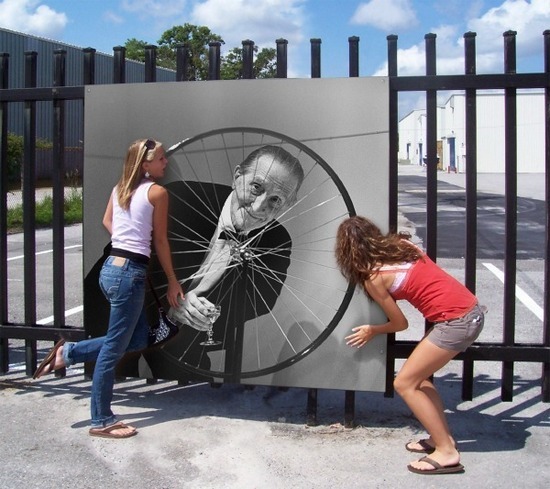
"In Advance" opened at 5AM on November 23, 2012 -- Black Friday -- and was billed as a "performance, concert and alternative to shopping at WalMart." A long queue of visitors, mostly young people and a lot of out-of-towners, snaked past the enlarged photos of Duchamp that had been bolted to the plant's fence, paying ten bucks each to gawk at the hanging tools. As the day wore on there was an ear-splitting concert by a local garage band who had christened themselves "Woman Ray," and a also a growing potluck of casseroles, brownies and tossed salads brought by well-wishers and served on paper plates. April and Ed Nordbee spent most of the day sitting behind a folding table playing chess on the plant's loading dock, selling Duchamp t-shirts, and taking it all in. "People were bringing me their blenders to sign -- I charged them five dollars for that -- and I also signed a few coffee grinders and some Tupperware."
By the New Year Nordbee had received enough attention and national press that her new public image had been secured: April Nordbee is now a brand, and also the subject of at least a dozen PhD theses in progress. "Apparently, I am the first female outsider/conceptualist to come out of this region, " Nordbee states with pride. "My timing was perfect." After her February, 2013 appearance on the Ellen DeGeneres show Nordbee signed a contract with a major gallery: her first show of readymades and signed found objects will open in New York this July. She also has licensing deals with Martha Stewart for a line of signature blenders and stainless steel backyard grills.
Although April Nordbee is now being heralded as a role model and an American success story, not everyone in Swedborg Falls is pleased. Crystal Anne Nordbee, the artist's opinionated 78-year-old paternal grandmother spoke her mind to reporter for USA Today:
"April doesn't call me anymore and I don't call her. Ever since she discovered that lazy-ass artist Duchamp April has become very greedy and self-involved. My late husband and I worked hard for everything we had -- we built this house with our own hands -- and I have no interest in so-called art by people who take no pride in what they put their name on. This country doesn't need greedy artists and overpaid CEOs who sell us over-priced worthless crap made by underpaid people in factories overseas. America needs doers and makers right now, not takers."
Author's Note: This piece is fiction intended as a commentary and social satire. April Nordbee, Swedborg Falls and its citizens are not real. Marcel Duchamp, on the other hand, was a very real and tremendously influential cultural figure.
↧
At Bergamot Station: Great Paintings for Every Taste
On a visit to Los Angeles a few days ago I saw enough terrific paintings to last me for awhile. I'm going to keep this blog short -- the images can do most of the talking -- but I do want to tell you that if you love painting you are going to be be impressed by the quality and variety of what you see at Santa Monica's Bergamot Station the next time you drop by.
![2014-06-05-13_SwainSMMOA001.jpg]()
Robert Swain: The Form of Color Installation at the Santa Monica Museum of Art, 2014, Courtesy of the Artist Photo by Jeff McLane
![2014-06-05-IMG_4196.jpg]()
The author's iPhone panorama of Robert Swain's The Form of Color
Moving right along, if you like looser approaches than Swain's -- much looser -- don't miss the spectacular two-man show featuring Ed Moses and Larry Poons at the William Turner Gallery just footsteps away from the SMMOA. The idea for this pairing apparently hit William Turner at Ed Moses' 85th birthday party three years ago when he noticed Moses and Poons standing on opposite sides of his gallery.
![2014-06-05-ScreenShot20140605at2.26.47PM.jpg]()
Artist Ed Moses with his paintings Edward #1 and #2
![2014-06-05-poons_diamond_jim.jpg]()
Larry Poons, Diamond Jim, acrylic on canvas, 76 1/2 x 102 inches
At Copro Gallery -- in Bergamot's "T" building just north of the SMMOA -- artist Adam Miller is showing four oil paintings and three drawings under the title "The End of Arcadia." Miller's theatrical and carefully staged paintings explore a heavy theme -- the end of the American Empire -- but do so with images that can only be described as challengingly beautiful. After seeing Robert Swain's immersive color installation and the dazzling painterliness of Ed Moses and Larry Poons, Adam Miller's show is going to offer you something completely different.
![2014-06-05-miller.jpg]()
Adam Miller, Apollo and Daphne, oil on canvas 72 x 48 inches
![2014-06-05-b_NightWatch4.jpg]()
Adam Miller, Night Watch, oil on canvas 60 x 72 inches
Another art-loving friend of mine has reminded me -- in talking about taste -- that "You have to stir the pot." If you can get to Bergamot Station before Adam Miller's show closes on June 7th and see the three shows mentioned in this blog, I can guarantee that your pot will indeed be stirred. If you don't like something you see there I will give you back the money you paid to read this blog: which is free. So is visiting Bergamot Station where parking, admission to the Santa Monica Museum of Art and admission to all the commercial galleries is also free.
Exhibition Information:
Robert Swain: The Form of Color
The Santa Monica Museum of Art
May 17 - August 23rd
Ed Moses and Larry Poons: The Language of Painting
The William Turner Gallery
May 31 - July 19th
Adam Miller: Twilight in Arcadia
Copro Gallery
May 17 - June 7th
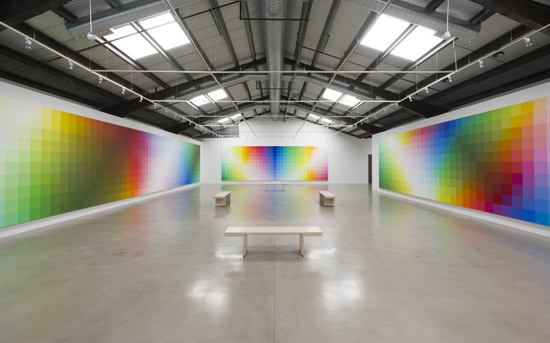

Moving right along, if you like looser approaches than Swain's -- much looser -- don't miss the spectacular two-man show featuring Ed Moses and Larry Poons at the William Turner Gallery just footsteps away from the SMMOA. The idea for this pairing apparently hit William Turner at Ed Moses' 85th birthday party three years ago when he noticed Moses and Poons standing on opposite sides of his gallery.

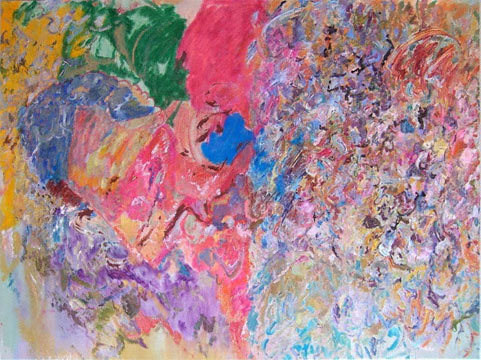
At Copro Gallery -- in Bergamot's "T" building just north of the SMMOA -- artist Adam Miller is showing four oil paintings and three drawings under the title "The End of Arcadia." Miller's theatrical and carefully staged paintings explore a heavy theme -- the end of the American Empire -- but do so with images that can only be described as challengingly beautiful. After seeing Robert Swain's immersive color installation and the dazzling painterliness of Ed Moses and Larry Poons, Adam Miller's show is going to offer you something completely different.


Another art-loving friend of mine has reminded me -- in talking about taste -- that "You have to stir the pot." If you can get to Bergamot Station before Adam Miller's show closes on June 7th and see the three shows mentioned in this blog, I can guarantee that your pot will indeed be stirred. If you don't like something you see there I will give you back the money you paid to read this blog: which is free. So is visiting Bergamot Station where parking, admission to the Santa Monica Museum of Art and admission to all the commercial galleries is also free.
Exhibition Information:
Robert Swain: The Form of Color
The Santa Monica Museum of Art
May 17 - August 23rd
Ed Moses and Larry Poons: The Language of Painting
The William Turner Gallery
May 31 - July 19th
Adam Miller: Twilight in Arcadia
Copro Gallery
May 17 - June 7th
↧
Zombie Conceptualism: The Next Art World Trend?

On April 3rd of this year critic Walter Robinson first identified and blogged about "Zombie Formalism," a multi-various and market-savvy approach that he sees as characterizing a recent clustering of artworks that have proved popular with art world speculator/flippers. I'm not sure if Robinson thinks the collectors or the artists are the Zombies that his new ism refers to, but I find the name he chose for this phenomenon grimly apt.
"Zombie Formalism" tends to be easy to understand and it favors novelty and off-hand effects and images: you can be newly "undead" and still get it. Because of its air of easy-going warmed-overness, "Zombie Formalism" seems to have some attitudes in common with "New Casualism," a related set of trends in abstract painting.
What would happen -- I have wondered -- if some of the deadpan hipster apathy of "Zombie Formalism," and also some of its grim self-confidence, were to hybridize with Conceptualism? Could "Zombie Conceptualism" be next?
Would we get effortless, tossed off conceptual jokes designed to entertain the "undead?" It seems like we already have "Zombie Performance," what with scrotums being nailed to Red Square and an artist eating his own hip.
I'm thinking that "Zombie Conceptualism," might just take some of the forms and directions you see pictured below...
Zombie Conceptualism
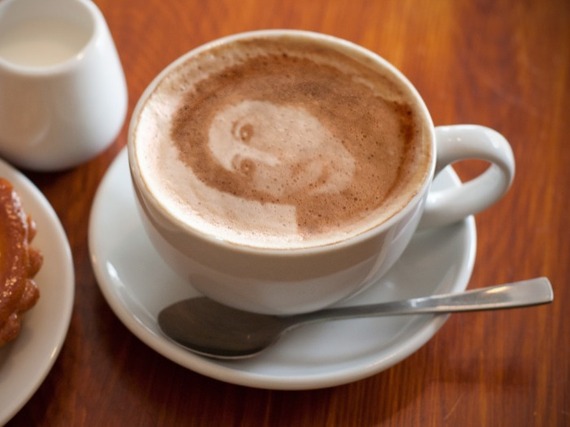
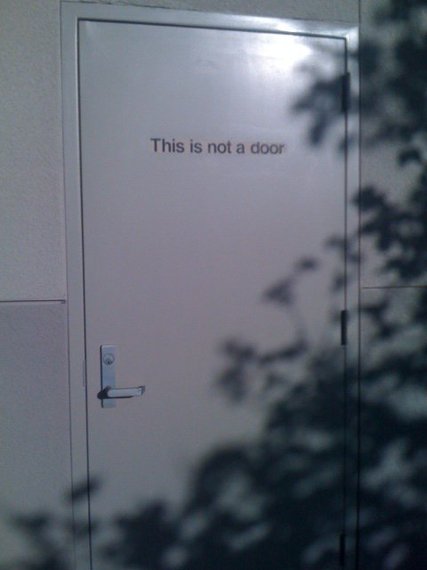
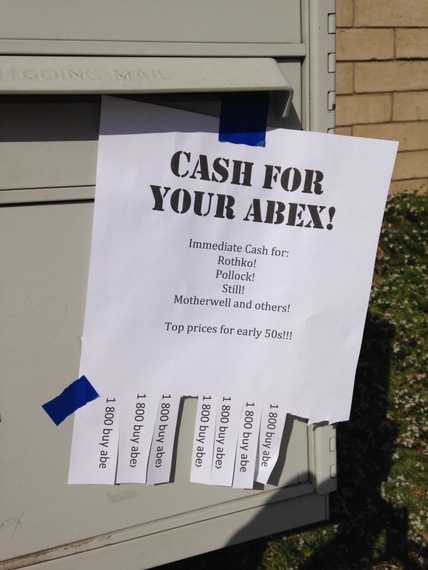
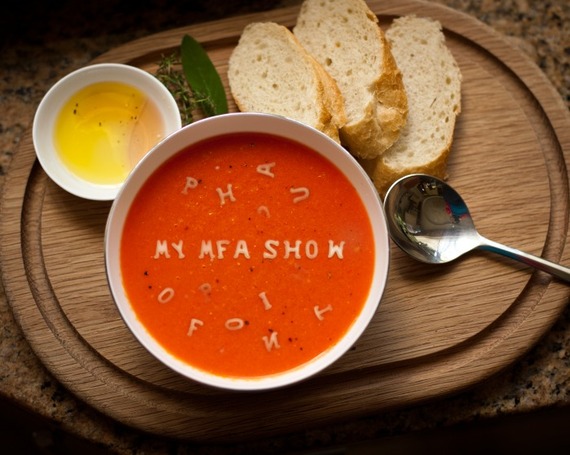
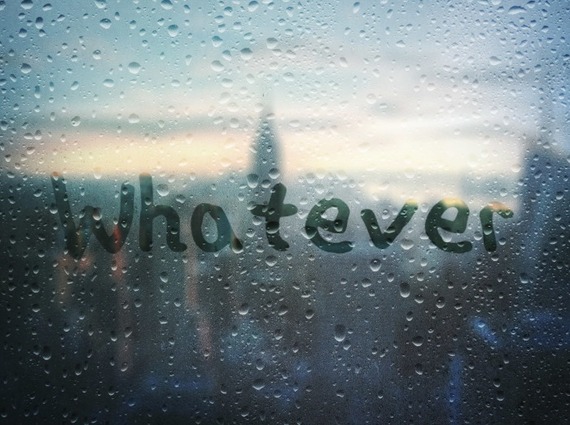

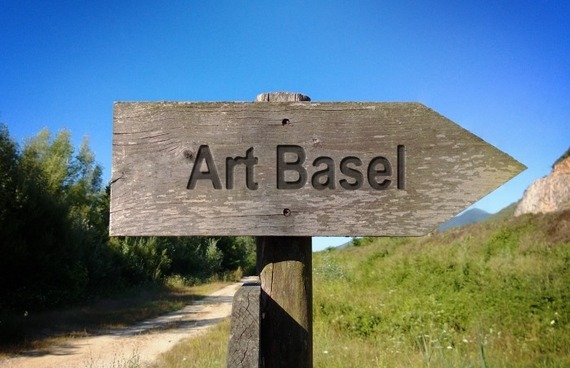
All Roads Lead to Art Basel, Wood-burned letters on Cedar, 4 1/4 x 17 1/2 inches
↧
↧
'Oneira: I Dream the Self' at Studio C Gallery in Los Angeles
I recently made my way to downtown Los Angeles to view Oneira: I Dream the Self, a group exhibition which dealt with the personal interpretation of dreams from a female perspective. Oneira was organized by Peggy Nichols, an artist who has transformed her working space at the Santa Fe Art Colony in Los Angeles into an open-by-appointment gallery and also a space for artist's workshops. Her creation -- Studio C Gallery -- is dedicated to exhibiting and emphasizing the work of women artists as a vehicle in bringing attention to the feminine characteristics and trademarks of art making.
After the show closed I was able to interview Peggy and ask her more about her gallery, the exhibition, and the the current situation of women artists.
![2014-06-18-awfulportrait.jpg]()
Peggy Nichols: the founder of Studio C Gallery
![2014-06-18-GalleryC_installation7001.jpg]()
Visitors at Studio C Gallery at the opening of the exhibition Oneira: I Dream the Self
It's taken some time to find a "real" studio. I lived 20 years in a one bedroom apartment. I substituted a studio with a homemade tent that I had built out in the backyard. It was about the size of a pop up. It was ideal for awhile but became too small a space, as I started to produce larger work.
I have often dreamed of having a sizeable enough studio where I could do my work but also create a salon type atmosphere, where other artists could come teach or share their work. This dream materialized about three years ago when I found a 2,200 sq. ft. studio space available at the Santa Fe Art Colony, in downtown Los Angeles. I jumped at the chance without hesitation.
Studio C Gallery started from doing a two person show with my studio mate. That show received such a great response, I decided to do another show the following year. I had often thought of collaborating with other artists, in organizing a group exhibition. For years, I have been diligent in getting my work shown but gallery representation has eluded me. I've heard the same complaints from other artists, especially women artists. I thought, to myself, "I have the space, what if I go ahead and organize a show regardless and see what happens?"
![2014-06-18-Potter_AllHerCares.jpg]()
Serena Potter, All Her Cares, Oil on Panel, 32 x 36 inches
![2014-06-18-2.J.SykesOndoyantoil201318X121500300dpi6in.jpg]()
Jill Sykes, Ondoyant, Oil on canvas, 18 x 12 inches What are some of the themes and ideas present in the works of Oneira: I Dream the Self?
When I sent out the Open Call for the Oneira show, I asked artists to submit work that possessed their personal interpretation of dreaming. It could be unconscious dreams as in dreaming or conscious dreams as in imagination. I looked for pieces that reflected both. I might add here, that we received hundreds of submissions from women artists all over the world.
There were way too many submissions for me to handle myself. I asked my esteemed colleagues, Betty Ann Brown, Ph.D, Professor of Art History, California State University, Northridge and Ada Pullini Brown, Associate Professor of Art, Rio Hondo College, Whittier, CA, to assist me in jurying the show. We were astounded at the quality of work we received: it was truly impressive.
![2014-06-18-Summoned.jpg]()
Carolin Peters, Summoned, Oil on canvas, 84 x 114 inches (triptych)
![2014-06-18-BettyShelton22TheProblemwithTranscendence22001.jpg]()
Betty Shelton, The Trouble with Transcendence, Oil on paper, 30 x 40 inches
![2014-06-18-dreamcrystals2.jpg]()
Peggy Nichols, Dream of Crystal Diving, Oil on canvas, 48 x 60 inches
Dreaming is a physical transformation into the unconscious, where our bodies can shape shift into whatever we desire. Tamara Ann Burgh's painting, Important Things Happen in the Woods has that characteristic with a metamorphic feeling. A woman stares back at us intensely, with acid green eyes. Antlers protrude through the top of her head. Her mouth morphs into a hawk's beak. She stands alone, at night, in the woods under a full moon. She exudes the fortitude of a shaman.
![2014-06-18-ImportantWoods001.jpg]()
Tamara Ann Burgh, Important Things Happen in the Woods, Watercolor, 22 x 18 inches
![2014-06-18-RobinHextrumSweptAway.jpg]()
Robin Hextrum, Swept Away, Oil on canvas, 34 x 56 inches ![2014-06-18-cade_6.jpg]()
Salem Cade, Ripley's Garden, Oil on canvas, 36 x 32 inches
![2014-06-18-Prokne001.jpg]()
Rowena Hannan, Prokne, Earthenware, 12 1/2 x 11 3/8 x 9 3/4 inches
The story goes. Prokne was the daughter of Pandion, King of Athens. She had a beautiful sister named Philomela. Prokne was betrothed to a cruel husband,Tereus of Thrace. He raped her sister Philomela and cut out her tongue to keep the rape secret. Unable to speak, Philomela weaves a robe to divulge the rape to her sister, Prokne. The sisters plan to revenge the rape by killing Prokne's son and feeding him to Tereus. After Tereus finishes the meal, the sisters produce the head of the beheaded son. He realizes what has happened and pursues the sisters with an axe. As they are about to be overtaken by Tereus, the sisters pray to the Gods to be turned into birds. Prokne is turned into a swallow and Philomela is turned into a Nightingale.
The prose reads: "Sister, my sister, O fleet small swallow. Thy way is long to the sun and the south but I fulfilled my heart's desired."
![2014-06-18-IMG_0340.jpg]()
Eleni Lyra, Archangel, Installation with photo, cloth and light (3 sets of hanging panels) 9' 9" x 6' 9"
She is unaware of the vision as she sleeps in peaceful repose, behind floral curtains. The viewer is the witness of her dream or transformation.
It is often that unusual objects appear in our dreams: something that we might pick up and use but has no functionality.
![2014-06-18-dandeliontablesettingonblack.jpg]()
Robyn Nichols, Noxious Lawn Companion. Medicinally complete. Beautifying Contradiction Sterling silver (fantasy place setting), 16 x 14 x 9 inches
How do you feel about the current situation of women artists, and specifically representational painters?
If you ask the average educated person, which artist they admire the most, they most emphatically will choose a male artist. If you probe further and ask who their favored female artist is, they are hard pressed to say. A majority of the time they will give you a blank stare. Women artists are breezed over in Art history classes. It is a given. This is a real shame.
There may not be many noted women artists recorded throughout history but the few that made the list have been phenomenal artists. We seem to think that the world has changed dramatically better for women and in many ways it has but not so much for women artists, I believe, regardless of what anyone says. Women artists are not held in the same regard as men.
I believe that women artists are getting more exposure then ever before but if you look at statistics it still is not where it should be. I am referring to Micol Hebron's ongoing art project: The Gallery Tally. The statistics do not lie. Getting gallery representation for women artists is difficult.
It is interesting. When I was looking at women artists for the Discipline show, it was very difficult to find figurative artists. I found few woman painters doing figurative, representational work. Most are conceptual artists or abstract painters. This was surprising to me. Are artists inclined to follow trends because it may be easier to get into galleries? I wondered about that. I had a gallery tell me once that they thought I should incorporate street art into my work, such as graffiti before they would consider in handling my work. That floored me. I didn't know what to say. Figurative work can be considered old fashioned.
It seems that Art schools are rarely teaching classical drawing and painting technique these days, so interests lie in other forms of creating work, which is valid. Artists have always been tuned into the higher universe, the cause and flow of what is to come. It matters not, but for me, I am a perpetual student of the classical. I believe wholeheartedly that this is the base from where all artists should start, no matter where they end up.
What are some of the workshops you are planning?
We have three Workshops planned this summer, at Studio C. Karen Atkinson of GYST, Inc. is doing a workshop designed to help guide artists through the important aspects of becoming an organized, professional artist. Then there is a workshop featuring both nude and clothed models in long poses for painters. Finally, Bill Perkins -- an art director at Disneytoons Studio -- will be doing a 3-Day intensive color workshop in late July.
There is information about all of these workshops available on the Studio C Facebook page.
Studio C on Facebook
Oneira: I Dream the Self
Participating Artists: Kaleeka Bond, Shaktima Brien, Ada Pullini Brown, Tamara Ann Burgh, Salem Cade, Rowena Hannan, Pamela Hassell, Robin Hextrum, Laura K. Johnston, Kathryn Jacobi, Eleni Lyra, Mary Ancilla Martinez, Hanneke Naterop, Peggy Nichols, Robyn Nichols, Star Padilla, Sierra Pecheur, Carolin Peters, Serena Potter, Linda Rand, Karrie Ross, Lorraine Serena, Betty Shelton, Jill Sykes, Hope Their, Page Turner, Shelli Tollman, Melora Walters, and Kimberly Webber
After the show closed I was able to interview Peggy and ask her more about her gallery, the exhibition, and the the current situation of women artists.
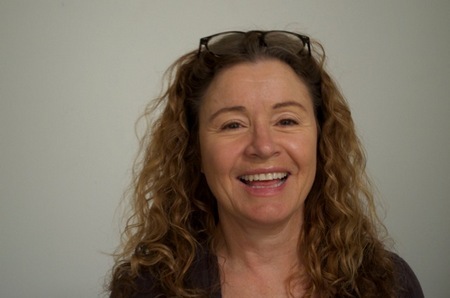
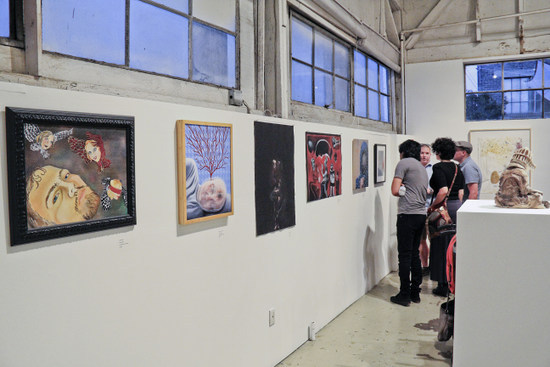
It's taken some time to find a "real" studio. I lived 20 years in a one bedroom apartment. I substituted a studio with a homemade tent that I had built out in the backyard. It was about the size of a pop up. It was ideal for awhile but became too small a space, as I started to produce larger work.
I have often dreamed of having a sizeable enough studio where I could do my work but also create a salon type atmosphere, where other artists could come teach or share their work. This dream materialized about three years ago when I found a 2,200 sq. ft. studio space available at the Santa Fe Art Colony, in downtown Los Angeles. I jumped at the chance without hesitation.
Studio C Gallery started from doing a two person show with my studio mate. That show received such a great response, I decided to do another show the following year. I had often thought of collaborating with other artists, in organizing a group exhibition. For years, I have been diligent in getting my work shown but gallery representation has eluded me. I've heard the same complaints from other artists, especially women artists. I thought, to myself, "I have the space, what if I go ahead and organize a show regardless and see what happens?"
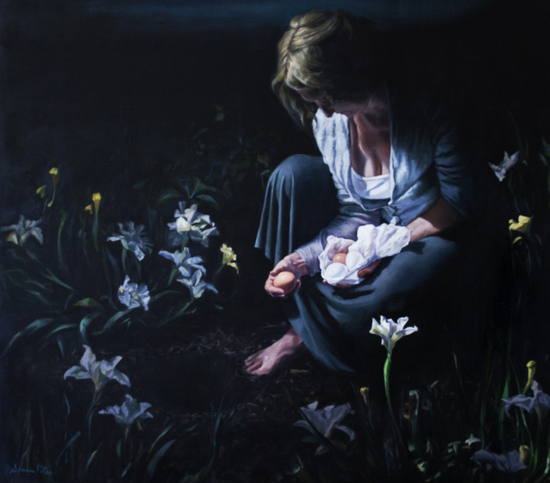
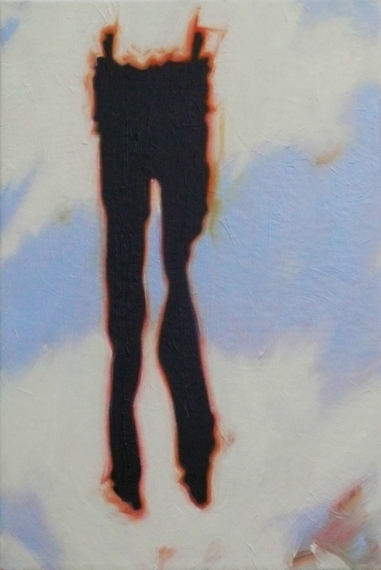
When I sent out the Open Call for the Oneira show, I asked artists to submit work that possessed their personal interpretation of dreaming. It could be unconscious dreams as in dreaming or conscious dreams as in imagination. I looked for pieces that reflected both. I might add here, that we received hundreds of submissions from women artists all over the world.
There were way too many submissions for me to handle myself. I asked my esteemed colleagues, Betty Ann Brown, Ph.D, Professor of Art History, California State University, Northridge and Ada Pullini Brown, Associate Professor of Art, Rio Hondo College, Whittier, CA, to assist me in jurying the show. We were astounded at the quality of work we received: it was truly impressive.
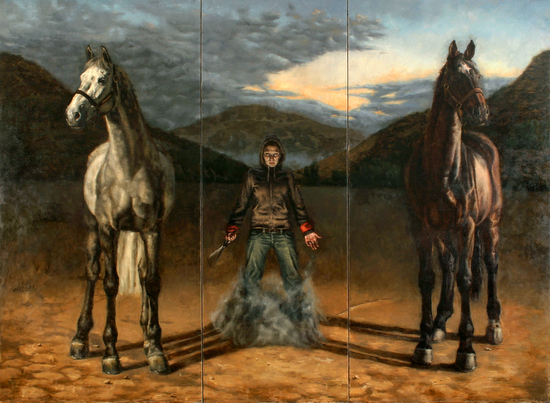
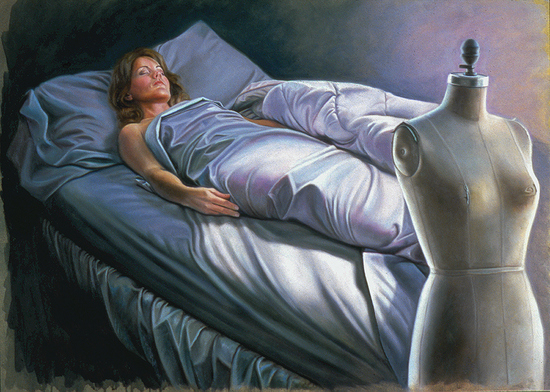
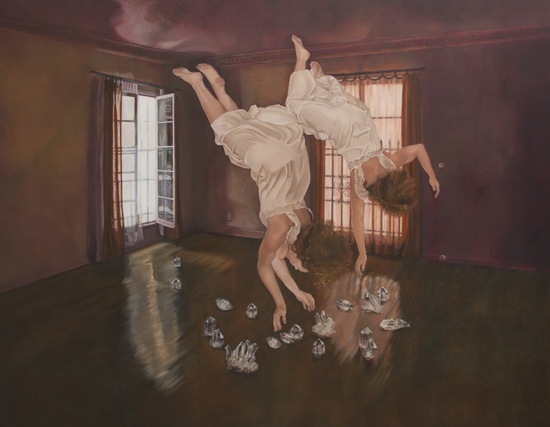
Dreaming is a physical transformation into the unconscious, where our bodies can shape shift into whatever we desire. Tamara Ann Burgh's painting, Important Things Happen in the Woods has that characteristic with a metamorphic feeling. A woman stares back at us intensely, with acid green eyes. Antlers protrude through the top of her head. Her mouth morphs into a hawk's beak. She stands alone, at night, in the woods under a full moon. She exudes the fortitude of a shaman.
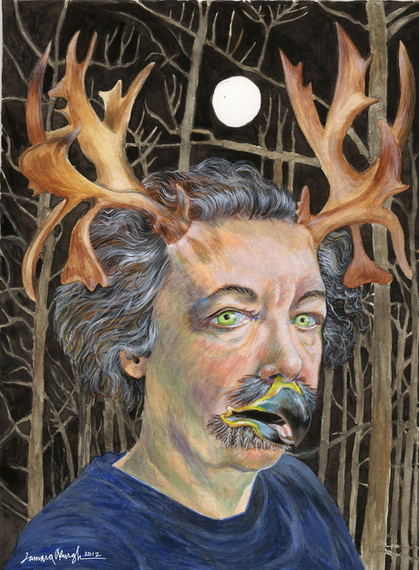
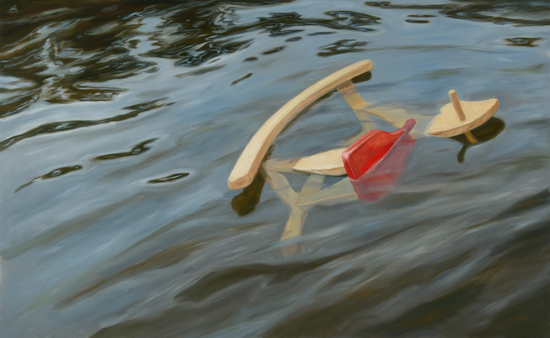
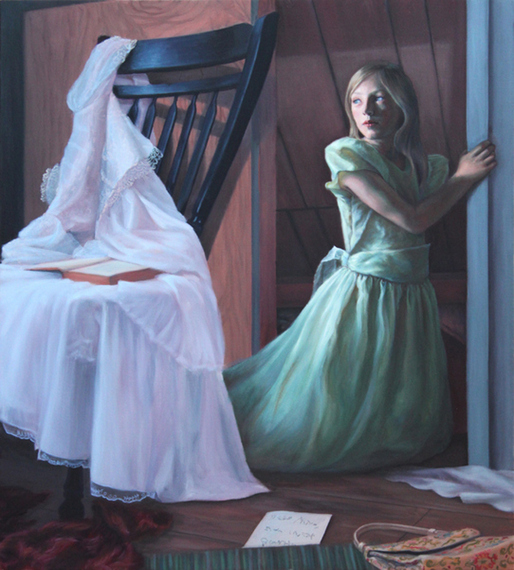
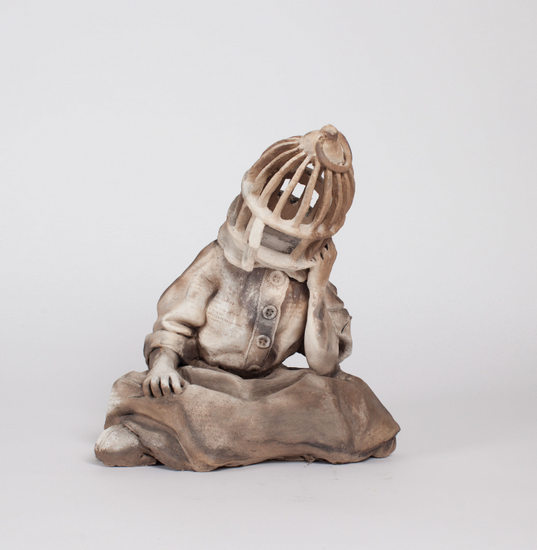
The story goes. Prokne was the daughter of Pandion, King of Athens. She had a beautiful sister named Philomela. Prokne was betrothed to a cruel husband,Tereus of Thrace. He raped her sister Philomela and cut out her tongue to keep the rape secret. Unable to speak, Philomela weaves a robe to divulge the rape to her sister, Prokne. The sisters plan to revenge the rape by killing Prokne's son and feeding him to Tereus. After Tereus finishes the meal, the sisters produce the head of the beheaded son. He realizes what has happened and pursues the sisters with an axe. As they are about to be overtaken by Tereus, the sisters pray to the Gods to be turned into birds. Prokne is turned into a swallow and Philomela is turned into a Nightingale.
The prose reads: "Sister, my sister, O fleet small swallow. Thy way is long to the sun and the south but I fulfilled my heart's desired."
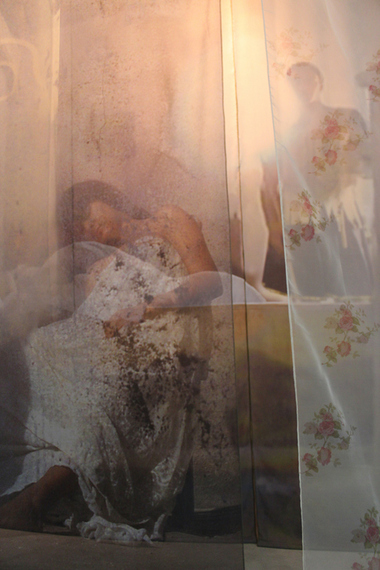
She is unaware of the vision as she sleeps in peaceful repose, behind floral curtains. The viewer is the witness of her dream or transformation.
It is often that unusual objects appear in our dreams: something that we might pick up and use but has no functionality.
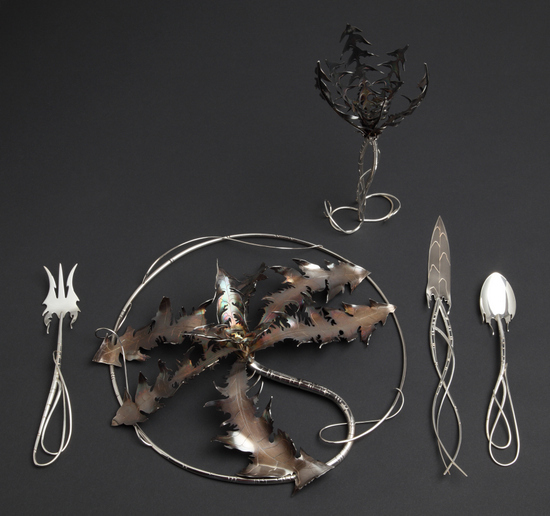
How do you feel about the current situation of women artists, and specifically representational painters?
If you ask the average educated person, which artist they admire the most, they most emphatically will choose a male artist. If you probe further and ask who their favored female artist is, they are hard pressed to say. A majority of the time they will give you a blank stare. Women artists are breezed over in Art history classes. It is a given. This is a real shame.
There may not be many noted women artists recorded throughout history but the few that made the list have been phenomenal artists. We seem to think that the world has changed dramatically better for women and in many ways it has but not so much for women artists, I believe, regardless of what anyone says. Women artists are not held in the same regard as men.
I believe that women artists are getting more exposure then ever before but if you look at statistics it still is not where it should be. I am referring to Micol Hebron's ongoing art project: The Gallery Tally. The statistics do not lie. Getting gallery representation for women artists is difficult.
It is interesting. When I was looking at women artists for the Discipline show, it was very difficult to find figurative artists. I found few woman painters doing figurative, representational work. Most are conceptual artists or abstract painters. This was surprising to me. Are artists inclined to follow trends because it may be easier to get into galleries? I wondered about that. I had a gallery tell me once that they thought I should incorporate street art into my work, such as graffiti before they would consider in handling my work. That floored me. I didn't know what to say. Figurative work can be considered old fashioned.
It seems that Art schools are rarely teaching classical drawing and painting technique these days, so interests lie in other forms of creating work, which is valid. Artists have always been tuned into the higher universe, the cause and flow of what is to come. It matters not, but for me, I am a perpetual student of the classical. I believe wholeheartedly that this is the base from where all artists should start, no matter where they end up.
What are some of the workshops you are planning?
We have three Workshops planned this summer, at Studio C. Karen Atkinson of GYST, Inc. is doing a workshop designed to help guide artists through the important aspects of becoming an organized, professional artist. Then there is a workshop featuring both nude and clothed models in long poses for painters. Finally, Bill Perkins -- an art director at Disneytoons Studio -- will be doing a 3-Day intensive color workshop in late July.
There is information about all of these workshops available on the Studio C Facebook page.
Studio C on Facebook
Oneira: I Dream the Self
Participating Artists: Kaleeka Bond, Shaktima Brien, Ada Pullini Brown, Tamara Ann Burgh, Salem Cade, Rowena Hannan, Pamela Hassell, Robin Hextrum, Laura K. Johnston, Kathryn Jacobi, Eleni Lyra, Mary Ancilla Martinez, Hanneke Naterop, Peggy Nichols, Robyn Nichols, Star Padilla, Sierra Pecheur, Carolin Peters, Serena Potter, Linda Rand, Karrie Ross, Lorraine Serena, Betty Shelton, Jill Sykes, Hope Their, Page Turner, Shelli Tollman, Melora Walters, and Kimberly Webber
↧
Universal Humanism or Identity Art? Which Works Better for You?
Whenever I meet people I always approach them from the standpoint of the most basic things we have in common. We each have a physical structure, a mind, emotions. We are all born in the same way and we all die. All of us want happiness and do not want to suffer.
- the Dalai Lama XIV in The Art of Happiness: a Handbook for Living
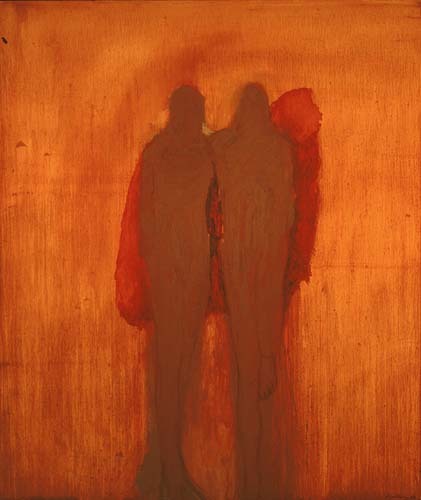
Couple with Red is an apolitical painting about how our humanity connects us and what we have in common. I'm going to characterize the approach of this painting as "Universal Humanism." It emanates an optimistic and utopian feeling of commonality. One of the essential elements of friendship -- and of a healthy society -- is the feeling of commonality.
When we as individuals feel excessive difference from others our social connections fracture and we retreat into smaller and smaller circles: I think of these metaphorical circles as "tribes" that keep us divided and create competition and conflict.
Yes, contemporary tribalism is a major problem -- just think about American politics and you will instantly know what I mean -- but commonality has its pitfalls too: hate groups can be built on themes of commonality.
Still, we all need friendship and we all need human connections. We can't survive or thrive as individuals or create any meaningful sense of identity without friends. In our polarized, fast-changing, aggressive society -- one in which the "self" is always being made insecure by consumerism -- personal identity is a fragile construction that needs to be defended and protected. Not surprisingly, identity is one of the leading themes of contemporary art.
In innumerable paintings, performances, videos, and installations, Postmodern artists concerned with identity have made political, sociological, cultural and personal points about the particularities of their situations. Gender, sexual orientation, ethnicity -- and other factors that have historically circumscribed, damaged and defined the lives of both groups and individuals -- are the raw material of Identity Art, which presents itself as being in opposition to hostile social and historical forces and contexts.
I am rather susceptible to Identity Art because it holds the possibility of broadening my understanding of others and increasing my empathy. I use art museums and galleries as my churches, and Identity Art -- when it works -- can be a kind of sermon that tells me how I might become a better person by understanding the situations of others. That is, of course, exactly what the artists who make Identity Art have in mind.
One artist who deals with identity in a way that speaks to me is Kerry James Marshall, whose works in many media have commented on race and black identity in a way that consistently strikes me as both authentic and aesthetically accomplished. Marshall, whose work is deeply rooted both in African-American history and his personal history has commented that: "You can't be born in Birmingham, Alabama, in 1955 and grow up in South Central [Los Angeles] near the Black Panthers headquarters, and not feel like you've got some kind of social responsibility." I buy that, and if I had the bucks I would buy his work too.
If you don't know Marshall's work take a few minutes to watch the video below and you will get a feeling of what his work looks like and where he is coming from.
Of course, not every artist who deals with identity is as accomplished or articulate as Kerry Marshall. And not all Identity Art is good art: not by a long-shot.
This brings me to one of the major problems with Identity Art: it can create a situation where really lame art seems to resist criticism because it stands for "good" progressive values. There is a great deal of Identity Art being made now that is shrill and contrived, but which gets a free pass from critics and curators because it presents its message as sacrosanct. As someone who writes about contemporary art I know that if I make critical comments about a work of art that deals with racism there is a chance I may be singled out as being racist, even if it is the aesthetics of the work that leave me cold. Identity art connects directly to hot-button social issues and that makes critical appraisals a real minefield.
Speaking of minefields, a recent blog posted by Ryan Wong on Hyperallergic -- I am Joe Scanlan -- caused a number of small explosions. In his blog Wong -- a curator and writer -- claims that he invented an artist by the name of Joe Scanlan who was carefully designed to "test the limits" of what he calls "straight white male positionality within in the art world." Joe Scanlan, as Wong tells the story, invented Donelle Woolford, a black female artist.
Amazingly -- or not amazingly, depending on how cynical you are about the New York art world -- Woolford's "work" was included in the 2014 Whitney Biennial. Ryan Wong claims that he was surprised "how long it took for the Joe Scanlan/Donelle Woolford project to be identified as racist." Here is the kicker: Wong's blog was a parody that added another layer of commentary to something real. Joe Scanlan is in fact a real artist who really did invent Donelle Woolford and who really does teach art at Princeton.
There is a lot to discuss here, but for me one thing really stands out: I'm amazed that the work created by Scanlan for his invented artist Donelle Woolford actually made it into the Whitney. Woolford/Scanlan's contribution to the show included an off-site performance called Dick's Last Stand which "explores the central role given to the male sexual organ in both American art and politics." Isn't there anyone in New York with a sense of humor who immediately recognized that as parody, not art? Of course, I didn't recognize Wong's blog as a parody until it was pointed out to me.
While heads spin and comment wars rage over all of this actual artists are left dealing with serious moral and philosophical questions such as "what do I want my art to say about the human condition?" One way that artists in the western tradition used to make statements about humanity was through allegory: they created stories and figures that symbolize and stand for ideas about human life. There seems to be a resurgence of ambitious allegorical painting going on right now -- I think I need to write a full blog about that -- but I'm presenting Patricia Watwood's remarkable Sleeping Venus below to provide an example.
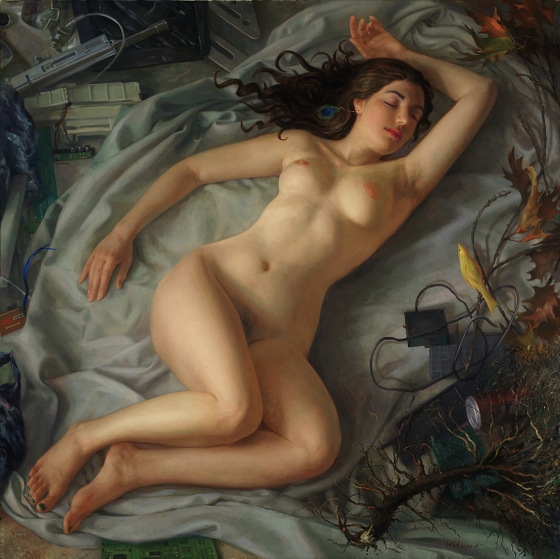
Patricia Watwood, Sleeping Venus, 2013, oil on canvas, 40" x 40"
In one sense Sleeping Venus is Identity Art: Watwood's allegorical image of the power of beauty as a tool of enlightenment has a hint of feminism about it. At the same time, it has something in common with the qualities that I admire in Nathan Oliveira's art. Sleeping Venus is a universal symbol of beauty, not a particular woman. If you have been looking at too much Identity Art -- or if you are determined to seek out every shred of political suggestion in every work of art -- you may see her as a privileged white woman.
When I look at works of art I am more interested than ever in a single question: "What do I have in common with the artist who made this?" Identity Art has its place -- although I do worry that in the wrong hands it can actually create divisiveness -- and I'm not going to say that we don't all need to know about the world's mis-alignments and injustices. Its just that at this point in my life I am so much more interested in what I have in common with others than in how we might be different.
Of course, I am a privileged white male, so maybe being able to approach art and people that way is my luxury. I'm always open to discussing that possibility...
↧
Michael C. McMillen's 'The Entropic Taxi; Final Destination' at the Palais de Tokyo, Paris
"In a decaying society, art, if it is truthful, must also reflect decay." - Ernst Fischer
![2014-06-27-Allthatfalls12.jpg]()
To enter Michael C. McMillen's new installation at the Grand Palais -- Entropic Taxi; The Final Destination -- visitors need to open a creaking pair of double doors below a spot-lit wooden sign that announces their destination: ELSEWHERE. I'm betting that the hint of existentialism will go over well in Paris.
Once inside, they discover curious patchwork dwelling accented by a rusted-out 1930 Citroën Rosalie perched at a tilt above a pile of leaves. The car is an elegiac image: a forgotten relic that moldered in the Loire valley for decades before being hauled into Paris for McMillen's piece. Most of the other materials used in the installation came from McMillen's home in Santa Monica: he still lives in the home where he was raised by his grandparents and he has been collecting evocative junk for decades. Paris is the "final destination" of a great deal of California debris from the artist's backyard...
![2014-06-27-Allthatfalls14.jpg]()
McMillen's piece is one of a flock of installations assembled by co-curators Mary Brugerolle & Gérard Wajcman as part of an exhibition titled All that Falls: "From the Berlin Wall to the Twin Towers, the twenty-first century was born in the fall," they philosophize in the exhibition catalog's opening statement. Along with twenty-three other artist/particpants McMillen was selected because his art deals with the dialogue between decay and redemption.
Like other installations he has previously created in the United States, Entropic Taxi; Final Destination combines detritus, cultural artifacts, street signs and even film. The entire installation was built with a 5 degree tilt in both the walls and floor: McMillen notes that this "produces an odd sensation in the visitor that is hard to identify at first."
![2014-06-27-Allthatfalls15.jpg]()
Inside the installation's ramshackle dwelling -- a kind of post-industrial hobbit house and workshop -- they eventually come across a chair that faces video tower. This "curious stack of analog technology" shows four of McMillen's surreal homemade movies, which are there both to add narrative suggestions and to entertain.
![2014-06-27-Allthatfalls16.jpg]()
One of the goal's of McMillen's piece is to "take you out of Paris," and the quirky, abandoned vibe of Entropic Taxi certainly does that. The Citroën Rosalie that tilts outside might be seen as a symbol roaring-20s optimism, a relic of the brief window of optimism that was felt in Europe before so much of Europe fell to Fascism and Hitler. It is truly one delicious piece of rusted-out automotive history. Of course, Mc Millen has put it in front of you to let you see if it holds any symbolic meaning for you as an individual. If he has done his job, the beautiful decay of his installation will remind you -- as the curators of All that Falls propose -- that "There are falls, which, like curtains, reveal and open our eyes."
![2014-06-27-Allthatfalls13.jpg]()
Video: Michael McMillen prepares for his Palais de Tokyo Exhibition: Final Destination from zac t on Vimeo.
The Entropic Taxi; Final Destination
All that Falls
The Palais de Tokyo
Through September 7, 2014
Artists:
Ronald Amstutz, Vasco Araújo, Julien Bismuth, Jean-Pascal Flavien, Dominique Ghesquière, Lola Gonzalez, Camille Henrot, Willy Kautz, Agnieszka Kurant, Julie Legrand, Urs Lüthi, Michael C. McMillen, Steve McQueen, Philip Metz, Deimantas Narkevicius, Tony Oursler, Daniel Pommereulle Benoit Pype, Delphine Reist, Lili Reynaud Dewar, Jimmy Robert, Miri Segal, Pablo Vargas Lugo. And with the participation of: Felix Baumgartner.
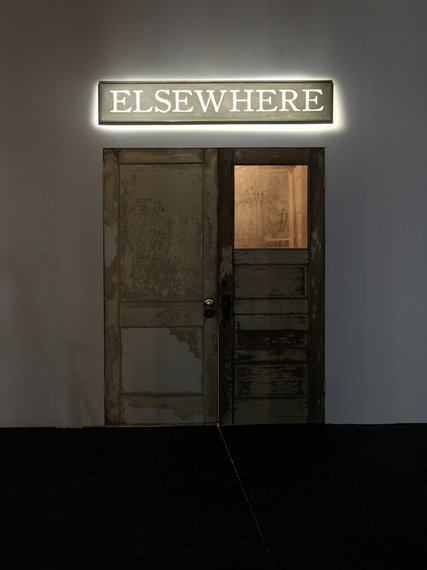
To enter Michael C. McMillen's new installation at the Grand Palais -- Entropic Taxi; The Final Destination -- visitors need to open a creaking pair of double doors below a spot-lit wooden sign that announces their destination: ELSEWHERE. I'm betting that the hint of existentialism will go over well in Paris.
Once inside, they discover curious patchwork dwelling accented by a rusted-out 1930 Citroën Rosalie perched at a tilt above a pile of leaves. The car is an elegiac image: a forgotten relic that moldered in the Loire valley for decades before being hauled into Paris for McMillen's piece. Most of the other materials used in the installation came from McMillen's home in Santa Monica: he still lives in the home where he was raised by his grandparents and he has been collecting evocative junk for decades. Paris is the "final destination" of a great deal of California debris from the artist's backyard...
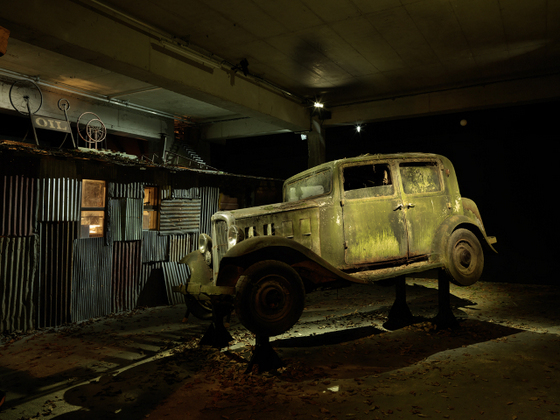
McMillen's piece is one of a flock of installations assembled by co-curators Mary Brugerolle & Gérard Wajcman as part of an exhibition titled All that Falls: "From the Berlin Wall to the Twin Towers, the twenty-first century was born in the fall," they philosophize in the exhibition catalog's opening statement. Along with twenty-three other artist/particpants McMillen was selected because his art deals with the dialogue between decay and redemption.
Like other installations he has previously created in the United States, Entropic Taxi; Final Destination combines detritus, cultural artifacts, street signs and even film. The entire installation was built with a 5 degree tilt in both the walls and floor: McMillen notes that this "produces an odd sensation in the visitor that is hard to identify at first."
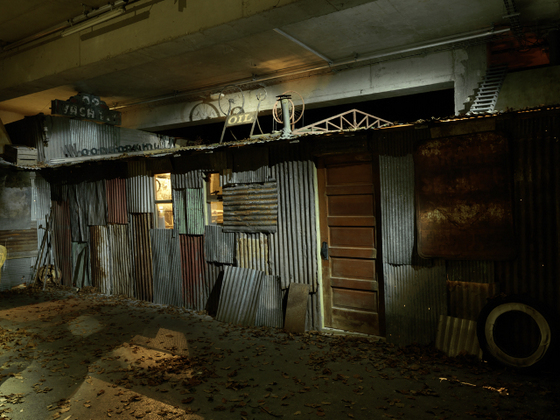
Inside the installation's ramshackle dwelling -- a kind of post-industrial hobbit house and workshop -- they eventually come across a chair that faces video tower. This "curious stack of analog technology" shows four of McMillen's surreal homemade movies, which are there both to add narrative suggestions and to entertain.
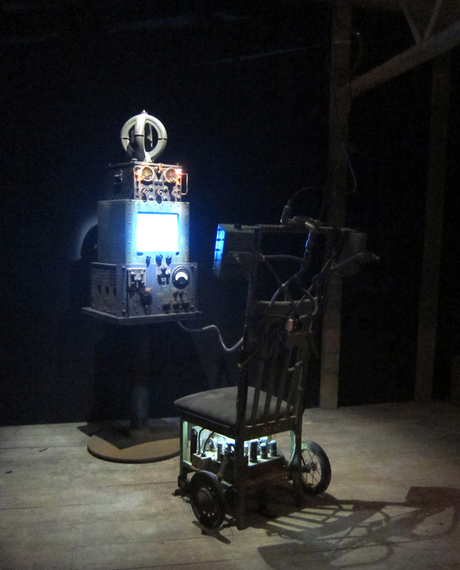
One of the goal's of McMillen's piece is to "take you out of Paris," and the quirky, abandoned vibe of Entropic Taxi certainly does that. The Citroën Rosalie that tilts outside might be seen as a symbol roaring-20s optimism, a relic of the brief window of optimism that was felt in Europe before so much of Europe fell to Fascism and Hitler. It is truly one delicious piece of rusted-out automotive history. Of course, Mc Millen has put it in front of you to let you see if it holds any symbolic meaning for you as an individual. If he has done his job, the beautiful decay of his installation will remind you -- as the curators of All that Falls propose -- that "There are falls, which, like curtains, reveal and open our eyes."
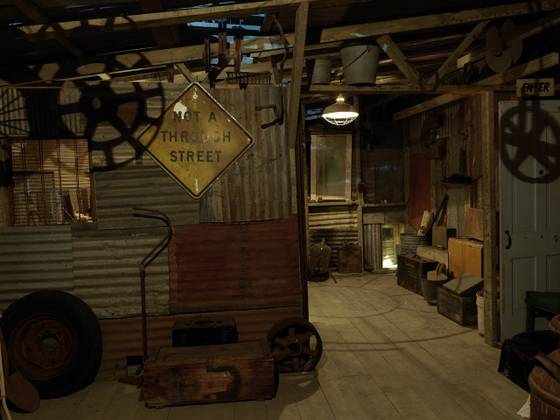
All photos courtesy of Michael C. McMillen
The Entropic Taxi; Final Destination
All that Falls
The Palais de Tokyo
Through September 7, 2014
Artists:
Ronald Amstutz, Vasco Araújo, Julien Bismuth, Jean-Pascal Flavien, Dominique Ghesquière, Lola Gonzalez, Camille Henrot, Willy Kautz, Agnieszka Kurant, Julie Legrand, Urs Lüthi, Michael C. McMillen, Steve McQueen, Philip Metz, Deimantas Narkevicius, Tony Oursler, Daniel Pommereulle Benoit Pype, Delphine Reist, Lili Reynaud Dewar, Jimmy Robert, Miri Segal, Pablo Vargas Lugo. And with the participation of: Felix Baumgartner.
↧
'Daniel Sprick's Fictions: Recent Works' at the Denver Art Museum

Daniel Sprick, whose work is now on view at the Denver Art Museum, has been creating paintings for more than a decade that make a similar point, but in reverse: any assumptions you make about his limits are very likely going to be wrong too. Sprick is an almost absurdly talented realist who it would be easy to label as a "tight" painter: he can lasso paint into perfectly limned contours and burnish human features into glowing, baby-bottom smoothness. Sprick can also let the paint run free and tell him what to do: underneath his realism he leaves patches of vivid, freely brushed abstraction. He also paints the wildness of hair with anarchic verve.

Sprick is many painters in one, and there is something conceptual about his approach. The conceptual element is there in the fact that each painting displays what the artist Vincent Desiderio calls a "narrative of creation." In other words, Sprick's paintings are utterly clear about how they are made: when seen as a whole they represent -- among other things -- a rebuke to photo-realism, which looks tame compared to what he does. Looking over a Sprick painting is an experience in being both "wowed" by his sheer bravura skill while also appreciating the artist's ability to balance his intellect with his intuition. Sprick paints hard and feels deeply.
As if Sprick didn't have enough to offer just in terms of virtuosity, there is another element to his portraits that has to be praised. You might expect that someone with his self-confidence could be detached from his subjects: far from it. Sprick has the knack for seeing people's inner vitality -- maybe it is related to his knack for understanding abstract energies -- and even when his portraits achieve refinement his subjects never lose their mojo. Take a look at the people that Dan Sprick paints and you will notice that however varied they are on the surface they all have one thing in common in emotional terms: they are all wide open to being painted by Daniel Sprick. They love being part of his oeuvre even though much of his work isn't flattering in conventional terms and there is at least a hint of affectionate caricature in his strongest works.
Honestly, who wouldn't want Sprick to paint their portrait? The man is a living master. Like Diebenkorn he is more than up to the challenge of surprising you with his versatility.
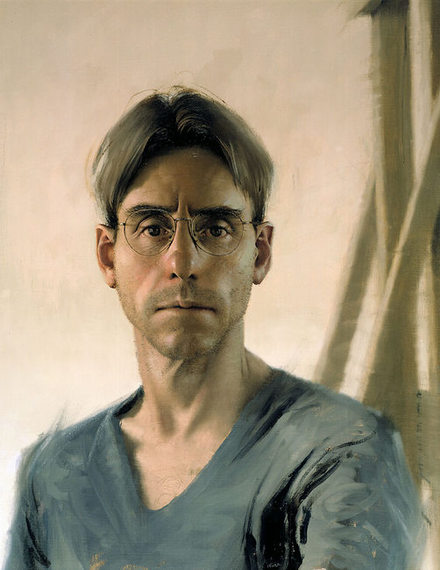
If you see yourself showing up in a short story, you may recognize parts of yourself that are drawn accurately, parts that are grafted from another model, and other parts from vapor and dusk. these narratives may be vague, but they are fictions, which was observed by Timothy Standring, who chose the title. When we paint, we internalize and filter all the raw data of existence through our sensibilities, experiences, abilities and shortcomings. We also mix in our habits, biases, preconceptions and aesthetic preferences. Then we stir it up with our natural emotional responses, and out comes -- lord knows what -- a variation on the initial experience. The end result is a kind of a daydreaming other world: a fictional world.
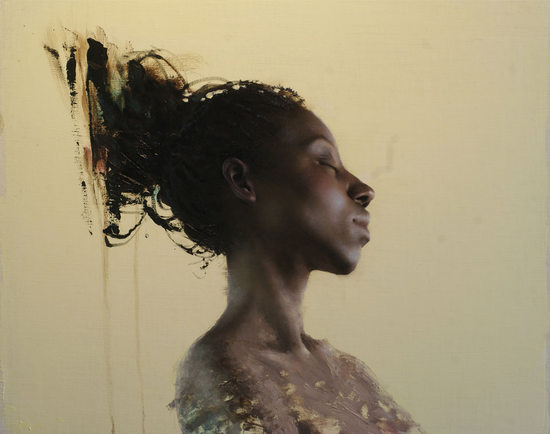
There was an article in which you discussed that there are various art worlds with little overlap or awareness of each other: parallel universes without contact. But I keep hearing the term ''bridge'' between traditional academic work and contemporary art as applied to this show. Christoph Heinrich, the director of the Denver Art Museum, has a background as curator of modern and contemporary in Germany, yet he shows genuine enthusiasm about this work and indicates that it dovetails with his goals. I am humbled by this, and very, very grateful.
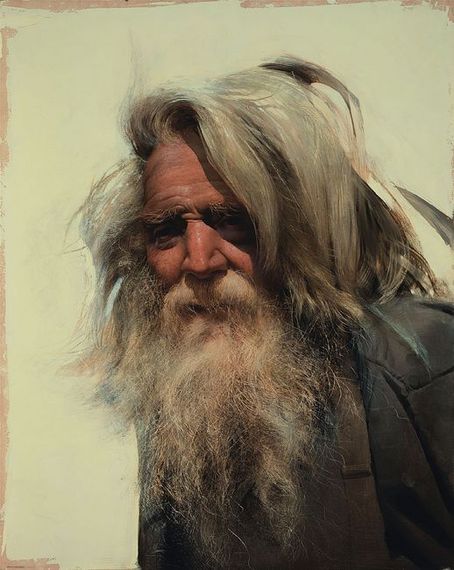
Curator Timothy Standring, who worked directly with me in Denver, said to a group after the reception that it is rare to have an opening in which people are actually looking at the paintings more than at each other. I heard reports of viewers moist in the eyes, and I noticed a bit of that myself. To connect on an emotional level is the most that an artist can hope for. Conversely, it will always be a big ol' world with many valid points of view, and none of us can expect 100 percent acceptance. I am presently reeling from the most carefully thought out, intelligently written, long, bitter and vitriolic attack I've seen against any one since elementary schoolyard days. Though it stings, I am flattered by the amount of effort he put into it. So thank you, mister.

An artist can internalize contemporary sensibilities, not so much by staying up to date on trends at Art Basel Miami, but by being true to him/herself and by indulging in the realm of the senses: observing and feeling, being influenced more by life itself than by the art world.
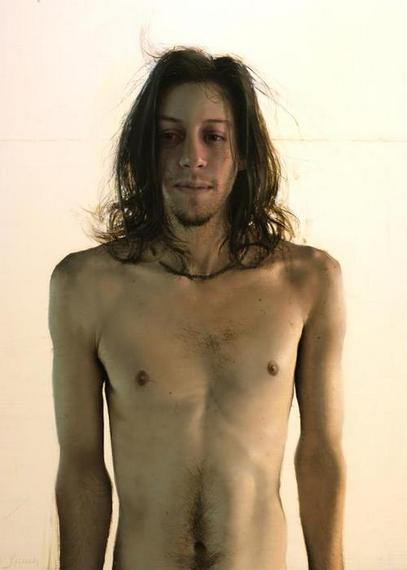
For years I've heard that the term ''de-skilling'' is being used in university art schools, apparently meaning that craft is believed to be an impediment to expression, and for sure: technical perfection as an end in itself can be lifeless. At the opposite end of the scale, if I am wildly expressive and full of emotion, in a language that no one recognizes, I am a man babbling in tongues out on the street. Then there is the art of no feeling and no craft either: supported by verbose and incomprehensible theories to keep investors buying into it.
Emotional expression can flourish when combined with highly practiced traditional academic skill. My taste leans toward understatement and subtlety. The works are not exactly accurate: they are embedded with errors due to my basic human shortcomings and also due to intentional exaggerations or caricature.
In the careful realism of my pieces there is also something in there that is a little bit wrong, but it may convey some interesting other world.
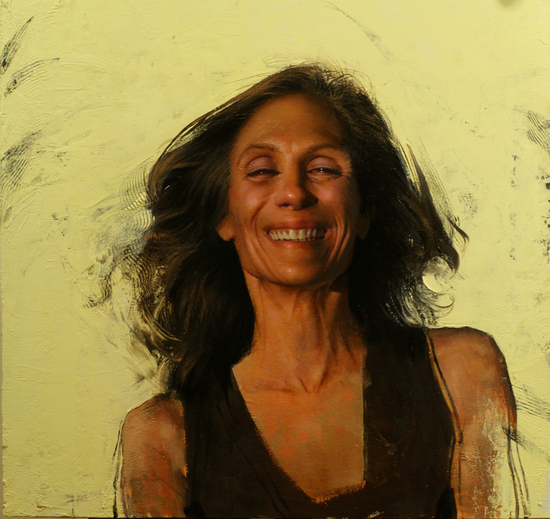
Nathan Oliveira conveyed an otherworldliness and expressed powerful emotion with recognizable figures during the heyday of Abstract Expressionism: his work constituted a bridge. Lucien Freud is another bridge artist between worlds; so is F. Scott Hess. There is a sequence, a progression from 1950's to today. I think that what I am doing follows in that sequence. It is possible to carefully craft artwork in the long tradition of realism while being expressive and relevant to our times. Realism was certainly not exhausted at the end of the nineteenth century.
All images ©Daniel Sprick
The Denver Art Museum
June 22, 2014 - November 2, 2014
Hamilton Building
↧
↧
Unsettled: Portraits by Peter Zokosky at Koplin Del Rio Gallery, Los Angeles

Zokosky isn't off-center just in terms of what he chooses to paint, but also in what he manages to make his subjects say. His stingrays -- which were inspired by a trip to the Long Beach aquarium -- are rather friendly. "They seemed to be asking to be painted," is how he explained it to a crowd of well-wishers during the opening. Can you think of another painter working today who is working to make cartilaginous fishes so inviting?
In contrast, Zokosky's babies and dummies are somewhat creepy: which you would expect from paintings of dummies... but babies? Zokosky steps back a bit from everything he paints: His curiosity has always had a scientific aspect. Long known for his paintings of apes -- who sometimes appear as artists at their easels -- Zokosky seems to see things the way that anthropologists used to: All Hominidae are really part of one big family.
Of course, what makes Zokosky's art really tick is the fact that he is a great intuitive thinker. Nothing in his art ever really adds up, and that is what makes his best work so unsettling. There isn't another artist out there who can take his intellectual caprices and play them out so completely or so elegantly. His canvases are tenderly painted, perfectly resolved -- in formal terms -- and glowingly lit. They not only ask questions, they multiply questions. Unsettled works by slowing you down and making you see things the way he does: with seemingly infinite curiosity and patience.
John Seed in Conversation with Peter Zokosky:
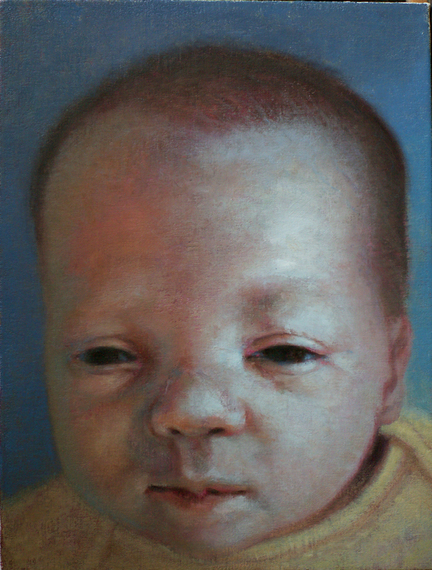
Good question: Babies are about as odd and strange as a human can be but still be considered beautiful. I painted one six feet tall, retaining its proportions and at adult size it was truly frightening. Their heads are enormous, and their arms and legs are tiny. Babies are beautiful because we love them, we don't love them because they are beautiful. It's a good illustration of how we are wired. We adore certain helpless creatures. Naturally, we all start as babies, so there is a universal, undifferentiated quality. Perhaps another appealing aspect is the pure potential they embody. I like the fact that we can care for and nurture these funny looking humans. They are hard to paint, they're so smooth and their faces lack to topography an adult has, they're like Arizona, lots of space between a few points of interest.
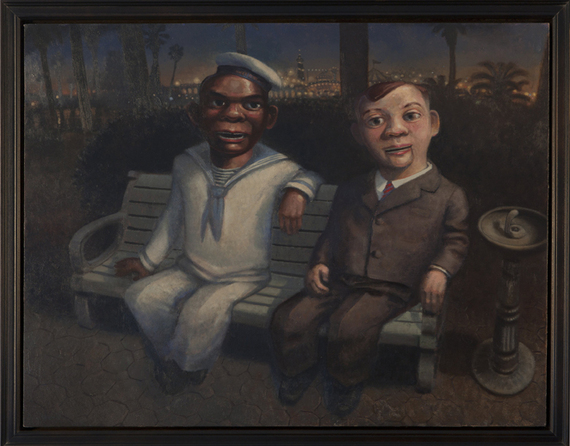
I suppose that's true much of the time. I don't try to make them creepy, or near-creepy, I try to make them engaging and interesting to look at. I like the uncertainty that comes with experiences that don't conform to expectations. Not quite cute, not quite horrible, that in-between space seems the most interesting, it's where growth can take place. For me life feels that way, and I think art has to function the same as life, or it seems false. You could argue that if life provides that experience then why ask art to do it, I'd respond that art is a distillation of life, it points to something vague and mysterious and makes it a bit more concise, if freezes it so that you can ponder it, maybe it helps you to deal with the unknown a bit. Disturbing things can be beautiful and gratifying when we see them in context.
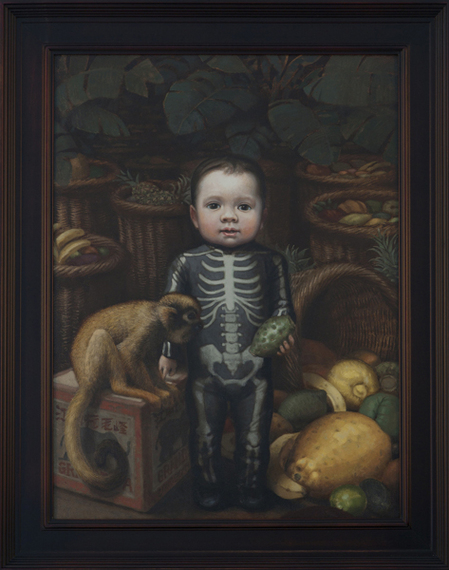
The self is all we've got: It's the portal to everything. My sensation of everything is limited to what touches this organism I call "me". Our eyes don't extend into new frontiers; they're not walking catfish, they're sea anemones, they're passive and they only ingest what comes to them. We share the room but each of us occupies our own space. What I mean is that all we can comment on is how we see things. I'm comfortable with the notion that every painting is a self-portrait of some sort in that it refers to our own interpretation of what we experience.

I'd say they all have shared aspects, to call them "human aspects" makes it sound like we invented it and they picked up on it. It's not so much that they seem like us, as much as we all seem alike. Vertebrates are pretty much variations on a theme. When we relate to them it's because we're similar. It feels like I'm splitting hairs, but I think there's a significant difference being discussed.
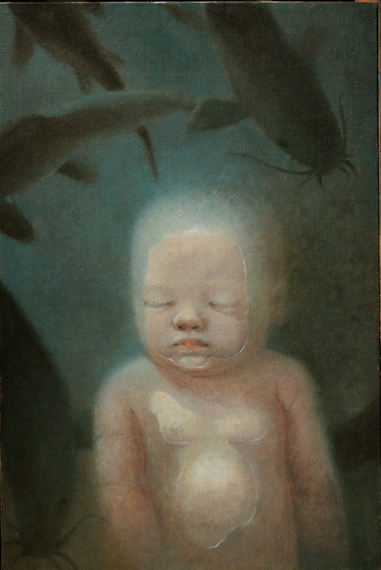
I suppose I'd like to hear someone say: "I hadn't thought of that subject as beautiful and important and interesting, but I can see how it is." I'd be disappointed to hear "creepy things are cool, and these are totally cool." I'm trying to point out things that are really meaningful, if you make the effort. They aren't a joke, I'm serious about what I do; which is not to say absurdity is out of bounds. I want the work to hold up, to remain engaging. I'm willing to forego the "wow factor" -- is that term still being used? -- in favor of the "hmmm... factor." I like a slow read, something that continues to unfold over time: I work hard to make these paintings beautiful. Another reaction I like is "That seems meaningful, I want to live with it." That's a great compliment.
Listen: Podcast interview of Peter Zokosky by Mike Stice.
Upcoming Event:
Peter Zokosky in Conversation with John Seed
Followed by a book signing of "Ten Rather Eccentric Essays on Art"
Saturday, July 26th at 4-6 PM
Contact Koplin Del Rio Gallery by July 23rd for reservations. info@koplindelrio.com
Exhibition Info:
Unsettled: Portraits by Peter Zokosky
June 28- July 26, 2014
Koplin Del Rio Gallery
6031 Washington Blvd Culver City, CA 90232
↧
John Seed in Conversation with Peter Zokosky: July 26 at Koplin Del Rio Gallery, Los Angeles
Dear Friends,
I hope you will consider joining me on Saturday, July 26th for:
There is no cost for this event, but please let the gallery know that you are attending as space may be limited. Contact: info@koplindelrio.com. See you there!
I hope you will consider joining me on Saturday, July 26th for:
"A Conversation with Peter Zokosky"
4-6 PM at Koplin Del Rio Gallery
I have known Peter now for thirty years. Knowing Peter, and watching his art develop over time has been very important to me. During the event at Koplin Del Rio I will be talking to Peter not only about his current exhibition "Unsettled" but I will also be asking Peter to reminisce about the old days, and talk about the roots of his art and ideas.
Peter and John at the bowling alley, circa 1984-85
Towards the end of our conversation, I also hope to say something about how Peter introduced me to a group of representational artists -- including F. Scott Hess, James Doolin and Jon Swihart -- whose brilliance and dedication to their art have shaped my ideas and made a huge impact on my writing.
Peter Zokosky, Noel, 2014, oil on canvas, 21 x 16"
At the end of the event, I will be signing copies of my short book of essays which will be on sale for $12.
There is no cost for this event, but please let the gallery know that you are attending as space may be limited. Contact: info@koplindelrio.com. See you there!
6031 Washington Blvd Culver City, CA 90232
↧
How Skype Visits from 17 Artists Transformed a Summer School Art Appreciation Class
It has been a number of years since I last taught a summer school class -- California's recent budget woes have been tough on community colleges -- so when I was told that I would have the chance to teach Art Appreciation this summer a surge of inspiration hit. Thinking over the opportunity I asked myself a question: "What can be done to make this summer's course especially interesting and memorable?"
The answer came to me rather quickly: bringing guest speakers to my class seemed like a great way to make the class fresh and vital. Since there is no budget available for speakers, I decided to try bringing visitors into my classroom via Skype video calls. Initially the plan was try Skype on a limited basis and see how things worked out: four or five guest speakers would be plenty. At the heart of my experimental class there would still be the backbone of a conventional class: students would read an assigned text, take quizzes and hear me lecture on relevant topics.
I posted a notice on my Facebook timeline asking for volunteers, mentioning that I was not able to offer compensation for speakers. Since I have been blogging about art and artists for four years, I knew that I had many artist Facebook friends to draw from. Within a week's time I had enough volunteers to schedule 17 guest speakers and also a list of alternates, many of whom have let me know that they will be happy to speak the next time that speakers are needed. I was amazed and pleased at the response. If you are a teacher, you should keep in mind that if speaking simply involves connecting with a class for 30 minutes via Skype there may be many people in your field willing to volunteer their time and expertise.
With my calendar filled up there was a practical concern to address: how would I ready the classroom for Skype visits? The room where I teach art history is a "smart classroom," which means that it features an overhead LCD projector connected to a computer which is in turn connected to high speed internet. As it turns out, all I needed to do was add a webcam and microphone to the computer so that my guests would be able to see the classroom and take questions from my students. I chose a Logitech HD Pro Webcam, which sells for $60.67 on Amazon.com and it worked very well. We had virtually no technical problems with Skype although there were some minor issues with video quality from time to time when our guests had intermittent internet service.
![2014-07-24-webcam.jpg]()
Logitech HD Pro Webcam C920
![2014-07-24-conor.jpg]()
Artist Conor Walton as he appeared in our classroom via Skype
Artist Thomas Wharton discusses a portrait presented on his website.
![2014-07-24-karen_a.jpg]()
Skype guest Karen Azarnia
A video clip of Lori Escalera's talk
![2014-07-24-dan_m.jpg]()
Artist Daniel Maidman appearing via Skype
![2014-07-24-karrie.jpg]()
Artist Karrie Ross appearing via Skype
![2014-07-24-chris_b.jpg]()
Artist Christopher Benson appearing via Skype
Our 17 Skype guest speakers (in order of appearance):
Conor Walton Sam Nejati Brenda Hope Zappitell Melinda Cootsona Karen Azarnia Lori Escalera Christopher Benson Serena Potter Karrie Ross Jean Paul Mallozzi Cynthia Grilli Nathan Lewis Daniel Maidman Nicole Santiago Catherine Ruane Peri Schwartz Thomas Wharton Larry Gipe
The answer came to me rather quickly: bringing guest speakers to my class seemed like a great way to make the class fresh and vital. Since there is no budget available for speakers, I decided to try bringing visitors into my classroom via Skype video calls. Initially the plan was try Skype on a limited basis and see how things worked out: four or five guest speakers would be plenty. At the heart of my experimental class there would still be the backbone of a conventional class: students would read an assigned text, take quizzes and hear me lecture on relevant topics.
I posted a notice on my Facebook timeline asking for volunteers, mentioning that I was not able to offer compensation for speakers. Since I have been blogging about art and artists for four years, I knew that I had many artist Facebook friends to draw from. Within a week's time I had enough volunteers to schedule 17 guest speakers and also a list of alternates, many of whom have let me know that they will be happy to speak the next time that speakers are needed. I was amazed and pleased at the response. If you are a teacher, you should keep in mind that if speaking simply involves connecting with a class for 30 minutes via Skype there may be many people in your field willing to volunteer their time and expertise.
With my calendar filled up there was a practical concern to address: how would I ready the classroom for Skype visits? The room where I teach art history is a "smart classroom," which means that it features an overhead LCD projector connected to a computer which is in turn connected to high speed internet. As it turns out, all I needed to do was add a webcam and microphone to the computer so that my guests would be able to see the classroom and take questions from my students. I chose a Logitech HD Pro Webcam, which sells for $60.67 on Amazon.com and it worked very well. We had virtually no technical problems with Skype although there were some minor issues with video quality from time to time when our guests had intermittent internet service.

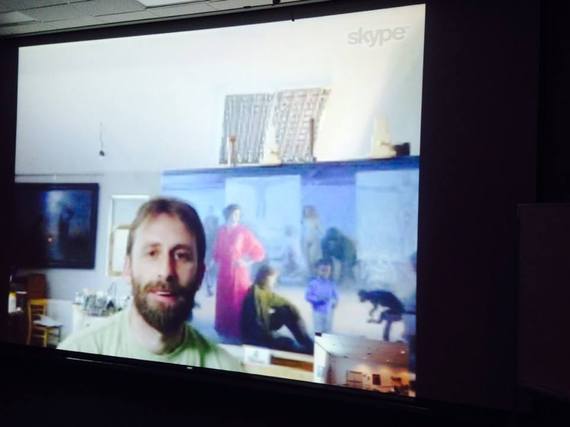
"One thing that I have found in common with all the artists that we have met through Skype is that each one has taken risks. They have fallen and gotten back up, not just in art but also in life."
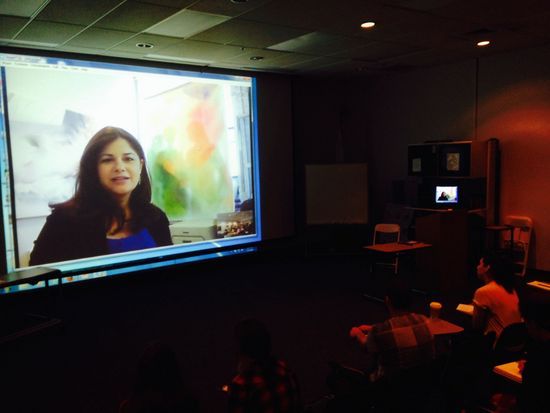
"Inside you, you know what is right for you." I must say it has stayed on my mind even until right now. It was said by a recent guest speaker: Thomas Wharton. It made me think of recent and future decision I have to make which I have been thinking about constantly, but when Thomas Wharton said that it was as if somebody shook me and said "wake up!"*** Sam Nejati said: "I look at painting as a human body or a symphony; every piece has to function. It is like me and the canvas have a conversation." I liked the way he expressed his views on what art and being an artist means for him.
*** My favorite artist so far has been Jean Paul Mallozzi. When we Skyped him, he said that he "purposely makes himself uncomfortable to be great." I am a musician and music teacher so I understand the importance of challenging yourself artistically.
*** The best thing that any of our guest speakers has said came from Nathan Lewis: "Art is a way to figure out who you are: it's not a competition."
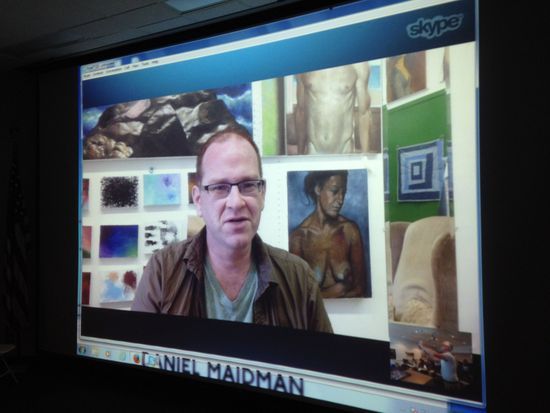
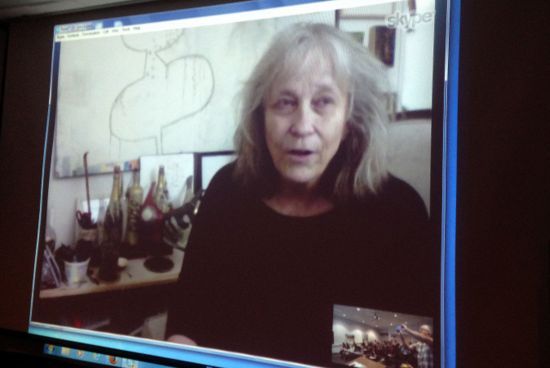
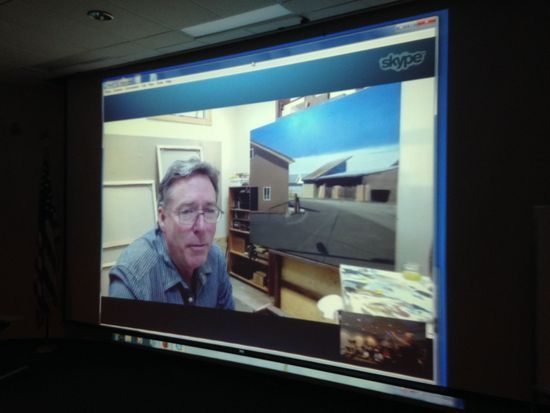
↧
Twitter Fights of the High Renaissance: Michelangelo, Leonardo da Vinci and Savonarola

A blog and video that recently appeared on the HuffingtonPost Arts page -- Why Leonardo Da Vinci Was A Loser (And What That Means For You) -- has apparently re-ignited a longstanding feud between Leonardo da Vinci and his frenemy Michelangelo. Here are a few highlights from a Twitter war that erupted after the blog was posted, along with a few comments from Savonarola...
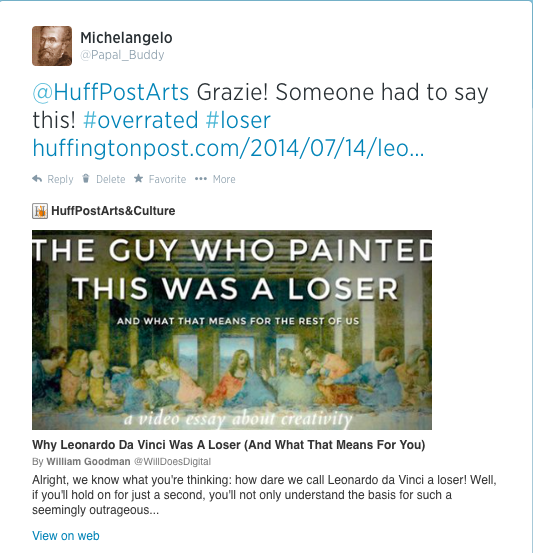
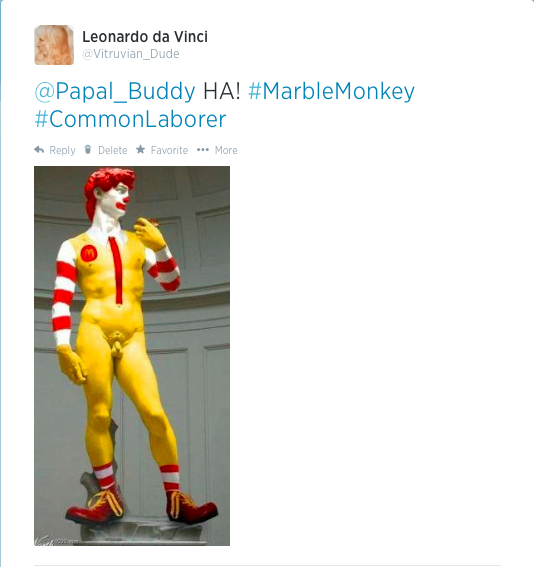

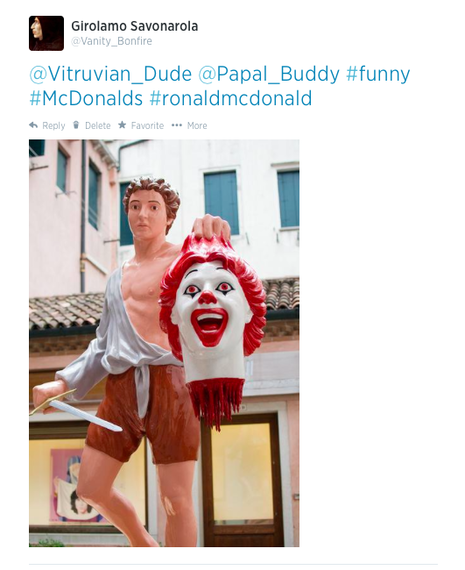

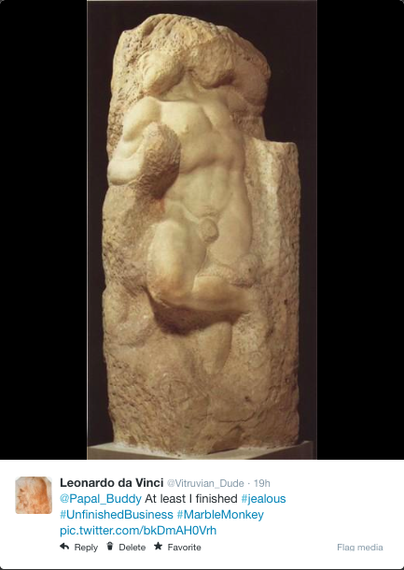

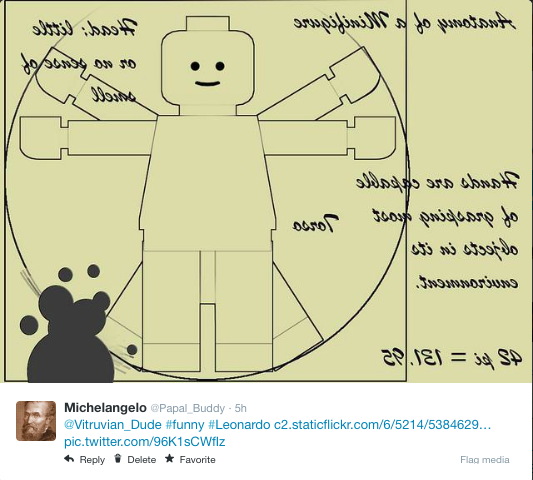


↧
↧
John Seed in Conversation with Peter Zokosky (Podcast)
↧
Tracey Adams: "Everything in my life is interconnected."
Artist Tracey Adams, who currently has a solo show on view at the Bryant Street Gallery in Palo Alto, draws her ideas and inspirations from a wide variety of fields including music, mathematics and science. In her varied works, all of these disciplines come together in visual form, in a process that Adams characterizes as involving a "synthesis of intention and chance."
I recently interviewed Tracey Adams and asked her about her background, her interests, and her priorities.
Tracey Adams in Conversation with John Seed
![2014-08-08-TraceyatWinfield2014.jpg]()
Tracey Adams
I'm very fortunate that my parents loved art and collected Japanese prints. My mother had a small ceramics studio in our house where I could play and I always had crayons and paper: she made sure I was enrolled in art and music classes and that I attended art camp during the summer. On Saturday mornings, we'd go to matinees, exhibitions and concerts geared specifically to children at UCLA. I was 3 when I started drawing and playing the piano. Always supportive of my interest in art, my mother entered a tempera painting I made when I was 5, Hot Dogs and Arrows, in a local art competition; it won third prize!
![2014-08-08-revolution1webencausticcollage40x40.jpg]()
(r)evolution 1, Encaustic, collage and oil on panel, 40 x 40 inches, 2014
As an undergraduate, I studied music theory and composition, which was interesting, but not terribly exciting. My group of peers at UCLA would get together and perform early music weekly. Each of us had the opportunity to conduct and that is what really excited me: bringing music to life through interpretation and performance.
In Boston as a graduate student in conducting, I worked at Northeastern University as assistant conductor for two years and at Harvard-Radcliffe University as conductor of the Graduate Chorale for one. Conducting requires physical movement and communication, like dancing, which was fun and incredibly fulfilling. I got to hang out with John Cage and Philip Glass, and both of those contacts inform my work to this day.
I moved to L.A. after graduate school and created my own performing group with two friends who are currently very involved in the classical music scene. While I no longer perform, music is part of who I am. It's present in the way I develop line and composition in my work; for each element in music, there is its corollary in art.
I was invited to be the 2014 Visual Artist for the Music at Menlo Chamber Music Festival and Institute this summer. When I asked the directors why they chose my work they mentioned my use of color and rhythm which reflects the transition from 19th to 20th century Central European composers that are being featured this year.
![2014-08-08-revolution9webencausticcollageonpanel30x30.jpg]()
(r)evolution 9, Encaustic and oil on panel, 30 x 30 inches, 2014
In 1991, after working for 11 years as a freelance musician, I longed for the solitude a studio practice could provide. There were always interpersonal issues working with musicians and staff. Additionally, I was limited in what I could achieve in the conducting field as a woman, even though I had a degree from a renowned music conservatory. I grew frustrated and impatient when preforming became less about the music and more about other things. So, I picked up my drawing pencils and would sit for many hours drawing peacefully and happily. The rest is history.
![2014-08-08-artMKTSF.JPG.jpg]()
Benthic Mapping 3,4 and 5 Encaustic on mesa paper, each 120 x 22 inches, 2014 Installed at the San Francisco Art Market, May 2014
Music theory is an analysis of relationships: intervals between tones -- melodically and harmonically -- rhythm and meter, scales and keys. The frequency of sound waves that produce pitch can be measured mathematically. This is a very simple response to a complex answer.
I often use mathematical formulae in my art. For example, in my current series, (r)evolution, I pre-determine the colors to be used, how many times they appear and how they appear in the composition. It is important how and where a viewer enters my painting and how his/her eye travels around the composition. (r)evolution is about pattern within a grid structure. Other series include a grid structure, but more organic gestures within that framework. I like to say that my work exists on the "continuum between gesture and geometry": I used that phrase as the title of my 2011 exhibition at the Fresno Art Museum.
![2014-08-08-BenthicRevolution2webEncausticonMitsumata40x26.jpg]()
Bethnic Revolution 2, Encaustic on Mitsumata, 40 x 26 inches, 2014
After seeing the Met's exhibition, the Painterly Print in the 80's I knew I had to learn how to make monotypes. I signed up for a class at the Provincetown Fine Arts Center and studied with one of the best, Michael Mazur. I received so much from him including his enormous generosity as a teacher. Monotypes are transfer paintings from plate to paper, created in the moment, and can be used as studies for future paintings or they can exist on their own as prints. I have made hundreds of monotypes and monoprints (using a matrix). In 2007, I learned a new, but similar process of making an encaustic (pigmented wax) monotype on a hot aluminum table. The most exciting works I've done have been my encaustic prints on Japanese scrolls. Some of them are 24' long and have been exhibited as groupings and walk-through installations in museum exhibitions.
![2014-08-08-June152014.jpg]()
Folded (June 15, 2014)
I love working with paper. My new series, Folded, deals with a way of representing time spent in the studio day-to-day through the use of folds. Each day has a certain number of folds I make that correspond to the day in the month. For example, the piece made on June 14 has 14 folds. The folds are different widths, corresponding to a calculation I made for each piece. The papers used are fragments of encaustic monotypes created on different Japanese papers; the monotypes were made close to the same time as the folded piece was made.
This project developed as my other collage projects have - out of a need to break away from whatever painting or show I'm working on in order to work in a less intense but more playful way. Initially, I set certain parameters for myself: the maximum time spent on each folded piece would be less than an hour and no piece would be larger than 12"x12". Many of the pieces are smaller.
Recently, I've begun to make my work larger as this has been such a fun break from painting. Collage has always been my default and comfort for those frustrating and trying moments in the studio and in life. It is the perfect balance of intention and chance.
![2014-08-08-Lumenis8EncMonoAcrylicOilweb32x52.jpg]()
Lumenis 8, Encaustic Monotype, Acrylic/Oil on Panel, 48 x 40 inches, 2013
My next step is to return to Roger's lab to get a look at specimen slides under the microscope. Once I have actual visuals, I'd like to begin work on a large installation that will include my scrolls and three-dimensional forms fabricated from my scroll paintings. The imagery would be the healing bacterium, each with its own unique shape, internal structure and color. I can visualize someday walking through this installation that might look like a giant petri dish -- bacterium suspended from the ceiling to the floor in the form of sculptures and scrolls. Once completed, I'd like to write a proposal and submit it to appropriate non-profit, science and art museums for possible exhibition.
![2014-08-08-BenthicRevolution4webEncausticonMitsumata32x21.jpg]()
Bethnic Revolution 4, Encaustic on Mitsumata, 32 x 21 inches, 2014
This one is tough, John. My sense of humor is communicated through conversations with friends and students more than through my art.
That said, in my current series, (r)evolution, I'm playful in my choice of color and rhythm e.g. placement and color of the circles. The Folded series is also playful. I'm also a pretty good mimic and can be very silly at times, dissolving into giggles easily. I'm able to laugh at myself, at mistakes I make, especially when teaching. I have the ability to see the lighter side of life's often illogical situations by not getting bogged down in the negative or trite: it's something I've focused on most of my adult years.
My perspective changed dramatically when, at 16, I read Ram Dass', Be Here Now. It was a life-altering book for me. Currently, I'm reading Kay Larson's, Where the Heart Beats: John Cage, Zen Buddhism and the Inner Life of Artists. It's a wise book that helps me maintain a live-in-the-present-moment perspective.
![2014-08-08-revolution4webencausticcollage36x36.jpg]()
(r)evolution 4, Encaustic and collage, 36 x 36 inches, 2014
Everything in my life is interconnected: my painting and current projects in the works, my yoga practice, my teaching, and my relationships.
At this point in your life and career what matters most to you?
Several things: what's most important to me is having the freedom to create the kind of art that is most fulfilling and not necessarily what a gallery/dealer wants. That is why I'm excited about my two latest projects. Also, it's important to pay it forward and give back where I'm able. At the other end of the spectrum, I take great joy and pleasure teaching yoga and Pilates. I have many responsibilities, but this one is special as it's not about me, but helping others with certain physical and emotional conditions regain their independence and live a more quality-filled life.
Tracey Adams: Current Exhibitions
Tracey Adams: Patterns of InfinityBryant Street Gallery - Palo Alto, CAJuly 15 - August 31
Outside/InK. Imperial Fine Art - San Francisco, CAJuly 15-August 31
SHIFT: Five Decades of Contemporary California PaintingMonterey Museum of Art - Monterey, CAMay 1-September 22
I recently interviewed Tracey Adams and asked her about her background, her interests, and her priorities.
Tracey Adams in Conversation with John Seed
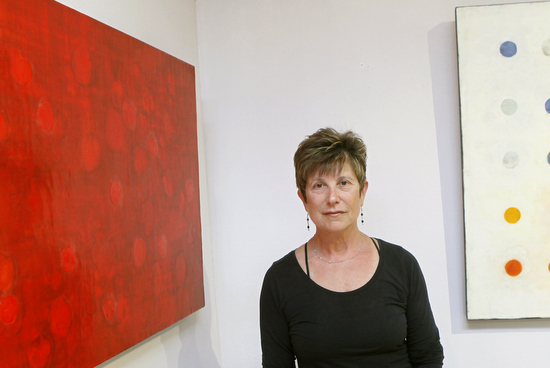
I'm very fortunate that my parents loved art and collected Japanese prints. My mother had a small ceramics studio in our house where I could play and I always had crayons and paper: she made sure I was enrolled in art and music classes and that I attended art camp during the summer. On Saturday mornings, we'd go to matinees, exhibitions and concerts geared specifically to children at UCLA. I was 3 when I started drawing and playing the piano. Always supportive of my interest in art, my mother entered a tempera painting I made when I was 5, Hot Dogs and Arrows, in a local art competition; it won third prize!
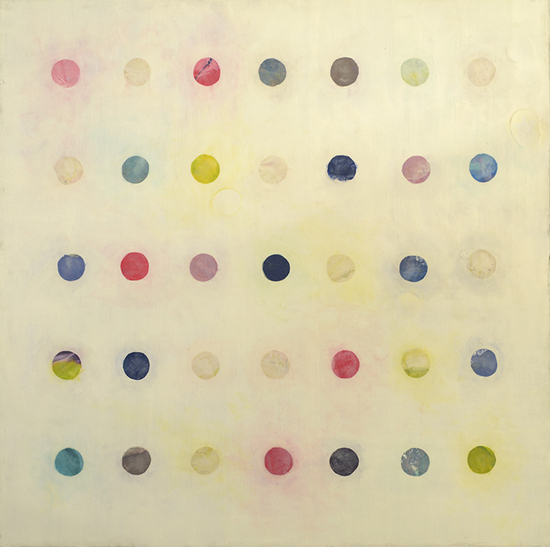
As an undergraduate, I studied music theory and composition, which was interesting, but not terribly exciting. My group of peers at UCLA would get together and perform early music weekly. Each of us had the opportunity to conduct and that is what really excited me: bringing music to life through interpretation and performance.
In Boston as a graduate student in conducting, I worked at Northeastern University as assistant conductor for two years and at Harvard-Radcliffe University as conductor of the Graduate Chorale for one. Conducting requires physical movement and communication, like dancing, which was fun and incredibly fulfilling. I got to hang out with John Cage and Philip Glass, and both of those contacts inform my work to this day.
I moved to L.A. after graduate school and created my own performing group with two friends who are currently very involved in the classical music scene. While I no longer perform, music is part of who I am. It's present in the way I develop line and composition in my work; for each element in music, there is its corollary in art.
I was invited to be the 2014 Visual Artist for the Music at Menlo Chamber Music Festival and Institute this summer. When I asked the directors why they chose my work they mentioned my use of color and rhythm which reflects the transition from 19th to 20th century Central European composers that are being featured this year.
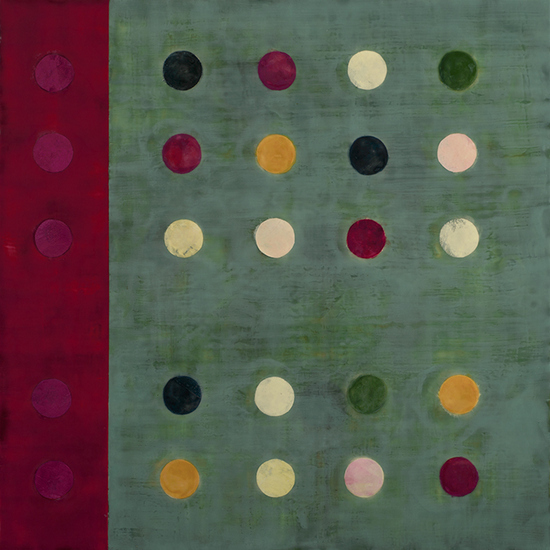
In 1991, after working for 11 years as a freelance musician, I longed for the solitude a studio practice could provide. There were always interpersonal issues working with musicians and staff. Additionally, I was limited in what I could achieve in the conducting field as a woman, even though I had a degree from a renowned music conservatory. I grew frustrated and impatient when preforming became less about the music and more about other things. So, I picked up my drawing pencils and would sit for many hours drawing peacefully and happily. The rest is history.
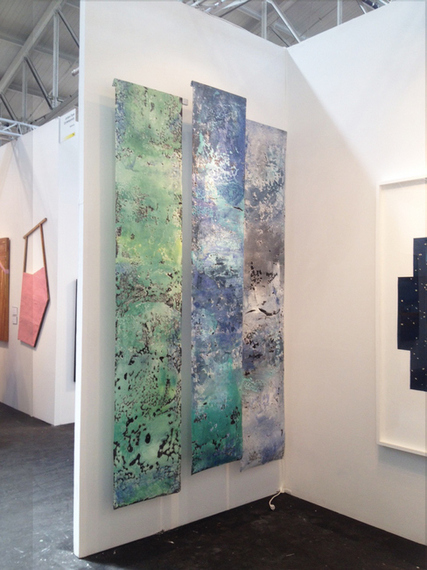
Music theory is an analysis of relationships: intervals between tones -- melodically and harmonically -- rhythm and meter, scales and keys. The frequency of sound waves that produce pitch can be measured mathematically. This is a very simple response to a complex answer.
I often use mathematical formulae in my art. For example, in my current series, (r)evolution, I pre-determine the colors to be used, how many times they appear and how they appear in the composition. It is important how and where a viewer enters my painting and how his/her eye travels around the composition. (r)evolution is about pattern within a grid structure. Other series include a grid structure, but more organic gestures within that framework. I like to say that my work exists on the "continuum between gesture and geometry": I used that phrase as the title of my 2011 exhibition at the Fresno Art Museum.
After seeing the Met's exhibition, the Painterly Print in the 80's I knew I had to learn how to make monotypes. I signed up for a class at the Provincetown Fine Arts Center and studied with one of the best, Michael Mazur. I received so much from him including his enormous generosity as a teacher. Monotypes are transfer paintings from plate to paper, created in the moment, and can be used as studies for future paintings or they can exist on their own as prints. I have made hundreds of monotypes and monoprints (using a matrix). In 2007, I learned a new, but similar process of making an encaustic (pigmented wax) monotype on a hot aluminum table. The most exciting works I've done have been my encaustic prints on Japanese scrolls. Some of them are 24' long and have been exhibited as groupings and walk-through installations in museum exhibitions.
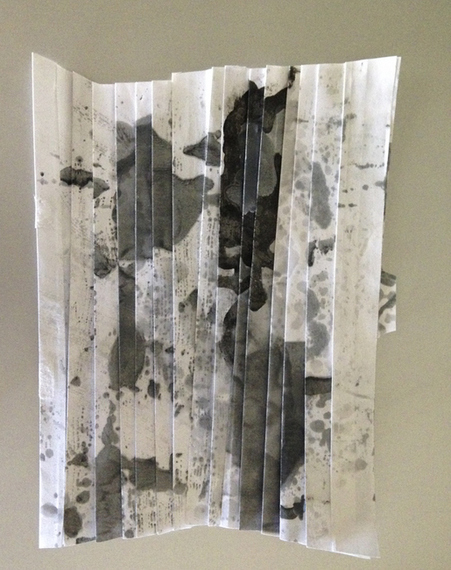
I love working with paper. My new series, Folded, deals with a way of representing time spent in the studio day-to-day through the use of folds. Each day has a certain number of folds I make that correspond to the day in the month. For example, the piece made on June 14 has 14 folds. The folds are different widths, corresponding to a calculation I made for each piece. The papers used are fragments of encaustic monotypes created on different Japanese papers; the monotypes were made close to the same time as the folded piece was made.
This project developed as my other collage projects have - out of a need to break away from whatever painting or show I'm working on in order to work in a less intense but more playful way. Initially, I set certain parameters for myself: the maximum time spent on each folded piece would be less than an hour and no piece would be larger than 12"x12". Many of the pieces are smaller.
Recently, I've begun to make my work larger as this has been such a fun break from painting. Collage has always been my default and comfort for those frustrating and trying moments in the studio and in life. It is the perfect balance of intention and chance.
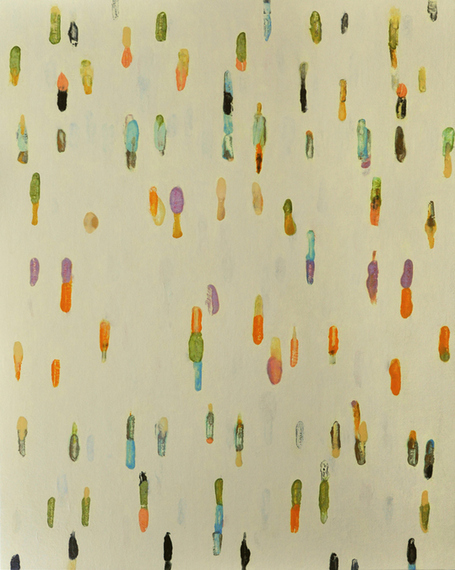
My next step is to return to Roger's lab to get a look at specimen slides under the microscope. Once I have actual visuals, I'd like to begin work on a large installation that will include my scrolls and three-dimensional forms fabricated from my scroll paintings. The imagery would be the healing bacterium, each with its own unique shape, internal structure and color. I can visualize someday walking through this installation that might look like a giant petri dish -- bacterium suspended from the ceiling to the floor in the form of sculptures and scrolls. Once completed, I'd like to write a proposal and submit it to appropriate non-profit, science and art museums for possible exhibition.
This one is tough, John. My sense of humor is communicated through conversations with friends and students more than through my art.
That said, in my current series, (r)evolution, I'm playful in my choice of color and rhythm e.g. placement and color of the circles. The Folded series is also playful. I'm also a pretty good mimic and can be very silly at times, dissolving into giggles easily. I'm able to laugh at myself, at mistakes I make, especially when teaching. I have the ability to see the lighter side of life's often illogical situations by not getting bogged down in the negative or trite: it's something I've focused on most of my adult years.
My perspective changed dramatically when, at 16, I read Ram Dass', Be Here Now. It was a life-altering book for me. Currently, I'm reading Kay Larson's, Where the Heart Beats: John Cage, Zen Buddhism and the Inner Life of Artists. It's a wise book that helps me maintain a live-in-the-present-moment perspective.
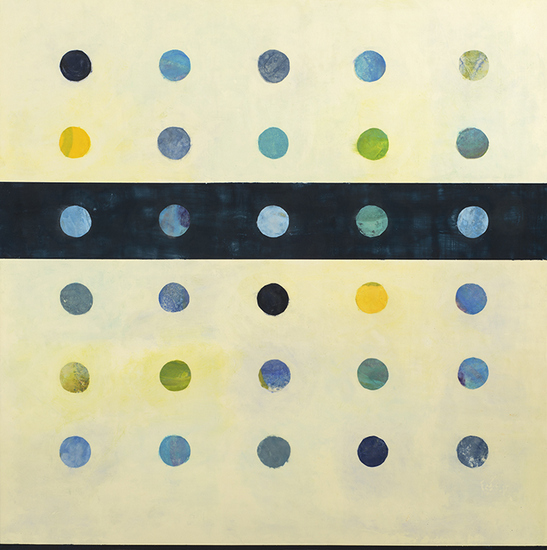
Everything in my life is interconnected: my painting and current projects in the works, my yoga practice, my teaching, and my relationships.
At this point in your life and career what matters most to you?
Several things: what's most important to me is having the freedom to create the kind of art that is most fulfilling and not necessarily what a gallery/dealer wants. That is why I'm excited about my two latest projects. Also, it's important to pay it forward and give back where I'm able. At the other end of the spectrum, I take great joy and pleasure teaching yoga and Pilates. I have many responsibilities, but this one is special as it's not about me, but helping others with certain physical and emotional conditions regain their independence and live a more quality-filled life.
Tracey Adams: Current Exhibitions
Tracey Adams: Patterns of InfinityBryant Street Gallery - Palo Alto, CAJuly 15 - August 31
Outside/InK. Imperial Fine Art - San Francisco, CAJuly 15-August 31
SHIFT: Five Decades of Contemporary California PaintingMonterey Museum of Art - Monterey, CAMay 1-September 22
↧
JeanPaul Mallozzi: Emotional States
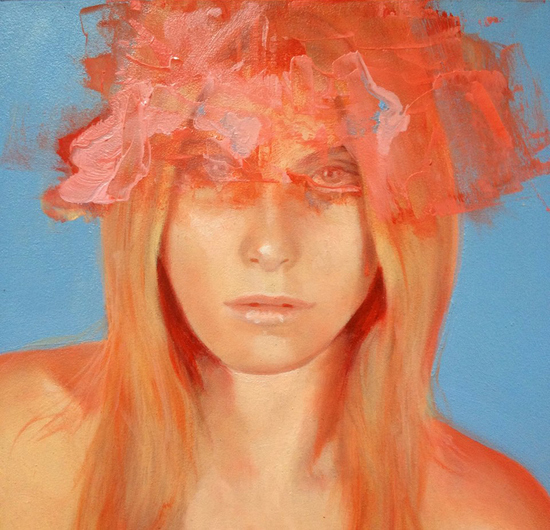
I recently spoke to JeanPaul Mallozzi and asked him about his history, his ideas and his recent work.
John Seed in Conversation with JeanPaul Mallozzi:
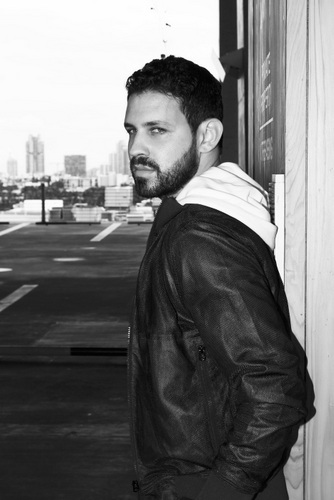
My parents immigrated to the U.S. from Italy and Cuba and settled in Queens, NY where I was born and raised. Being the youngest of four siblings in an immigrant household, telling my parents I wanted to be an artist didn't really inspire much confidence or praise: just eye rolls and heavy sighs. Thankfully my older sisters and brother had my back, but I still had to work hard to prove I was actually a good artist. I struggled like most artists to develop real confidence in my skills and techniques and I think it was harder because it was instilled by my parents in me to be humble. It wasn't an easy mental balancing act.
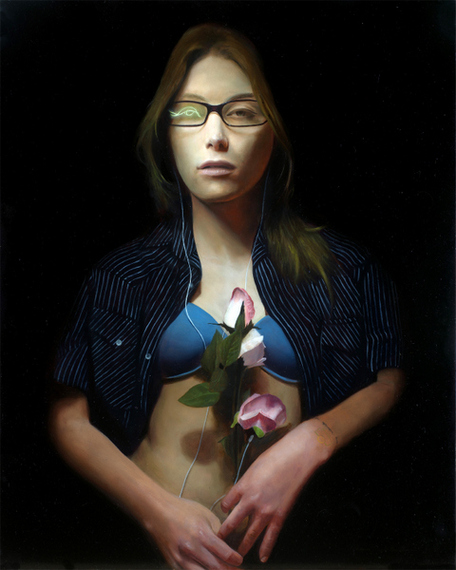
RISD was intimidating as HELL. I received a scholarship to attend -- that blew my mind -- but once I was there I realized that I was placed in a small pressure cooker loaded with talented people. The do I really belong here? thoughts made regular appearances. It was a hard time to keep the increasing self doubt in check while tasked with an intense regiment to make "quality" work for studio classes every week. However, all that time spent honed and strengthened my skills and brought out speed which is a great asset to have in this field.
As far as my portfolio being stolen, it was literally the last day of my Junior year in college and I was moving my stuff out of the apartment. I left the portfolio downstairs for a few minutes. When I came back from bringing down another box it was gone and I was beside myself with disbelief. Three years of work gone and most of it not photographed at that point.
Some time later I found out from a girl who contacted me after she saw one of my pieces -- one of the few I had a photo of -- on MySpace I had as a profile picture. She told me she bought one of those missing pieces and that it was hanging in her living room. She said it was sold by the "artist" who was trying to get across the country. She was kind enough to send it back to me. But that theft basically left me unable to get commissions/jobs for a while because I did not have enough time to develop that much new material in a year.
So I spent the next few years saving money doing other jobs like waiting tables, gallery assistant etc. Eventually I got into a studio residency and quit my "day" job. I spent all my time making a new body of work with no prospects just hoping something would happen. Fortunately, something did. I was picked up by a gallery in London and it snowballed from there.

Representational work struck me as a kid and I have a huge love for it. I was in awe of artists who were able to create a convincing alternate reality of their own and be baffled as to how they did it. I've had some great mentors like Nick Jainschigg and Shanth Enjeti both of whom have had a profound influence on me and my work. Nick being a master at painting realism taught me a lot of nuts and bolts. Shanth was teaching Character Design at the time and I'll never forget him telling me that while I can paint very well..."if the concept is sh*t and it's painted beautifully, it's a beautifully painted piece of sh*t".
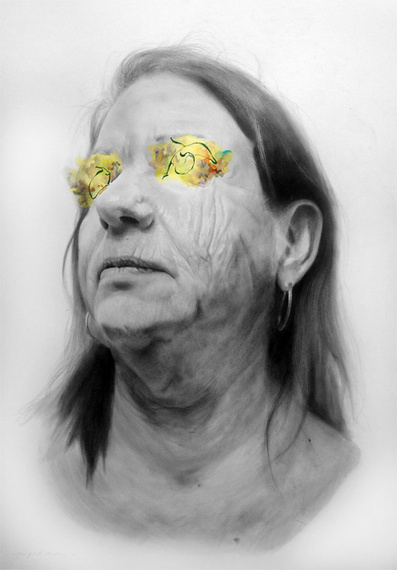

As I got older I found myself "reading" other people's emotions a lot especially during long train or bus commutes back home from the city. I would just sketch them in my book capturing their energies, their moods, their stories. If it wasn't on their face, then I'd key in on their body language. The way they sat or slouched, held their bags, talked on phones. Also, I come from an upbringing where pretty much everyone wears their emotions on their sleeves. When there's laughing, it's loud. When there's a fight, it's very loud! In both cases, neighbors have ended up coming over to join the party or calling security to keep the noise down.
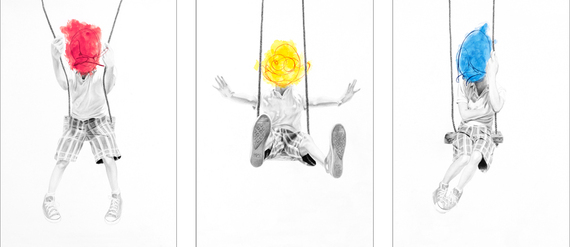
I had a literal moodswing in my apartment over five years ago and I wanted to reinterpret that visually, and thats where my personal work started took over other projects at the time. The stylizations and abstractions mimic facial features like eyes and smiles/frowns. Over the years, the abstractions have become more controlled and recognizable. I tend to do the highly abstracted faces with contoured lines when the figure is in a heightened emotional state, usually when they're in some sort of movement. Emotions are amorphous and different spectral colors give off different frequencies that people respond to. Its there like a keyhole to show the viewer the energy present inside the person at that moment.
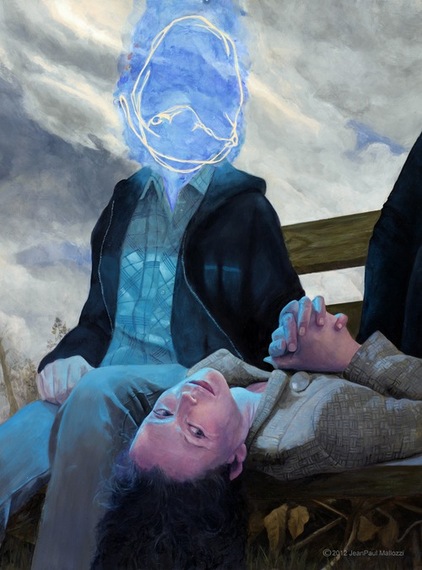
The title has a double meaning. The first taking the title literally. The other side, I made this painting during a time when I was head deep in a rough relationship. I found myself "going through the motions" knowing things were at an end, just waiting for one of us to make the move to end it officially. I wanted the guy's gestural face to mimic a sad smile looking down on her, but the woman looking at you (the viewer) as the object of affection. You become the greener pasture. It's about having the courage to break away from something you know isn't healthy for you any longer.
What will you be showing at Copro Gallery? Nathan Spoor was incredibly kind enough to invite me to show at this year's group exhibit called Suggestivism: Chronology. It's a recurring group show Nathan spearheads and this is the 5th installment; the last one being held in Rome, Italy. All the exhibiting artists portray figurative work that all suggest there is something more there than it seems to be on the surface. Here is how Nathan explains the show's theme:
At it's basic level, Suggestivism is based on the artist's specific and unique vision, a psychological or even mystical manifestation brought into reality by the artist's personal aesthetic. It's often representational, almost always in fact, but it is never restricted to being figurative or needing to include the figure.
I find myself in the company of incredible artists that I respect so much including Nicola Verlato, Aron Wiesenfeld and Marco Mazzoni.
The exhibit is currently running until September 6th. Due Venti (Two Winds) I created for this show as a farewell to a theme I was exploring. The girl carried off by two winds which are represented by two birds in flight while listening to her headphones plugged into a flower suggesting she's literally seeing the world from a different place--not plugged into technology but into the natural world. It's the last in the series so I thought it appropriate to send her off in style.
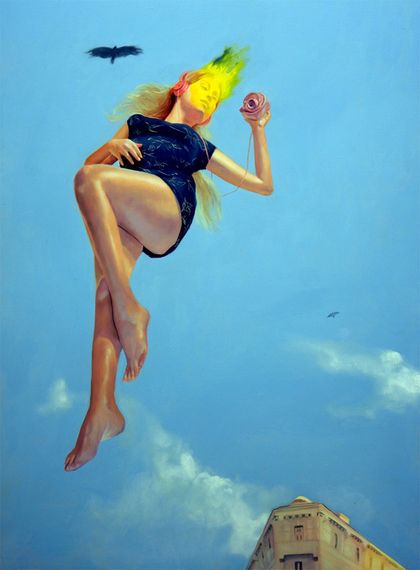
I've made a conscious shift and am bringing the optimism that some of my works on paper give off to the canvas. We've all reached out for help at some point in life. I'm portraying people who are asking for help, comfort, release and having that help manifest as a "familiar" or spirit guide. I'm also building on the colors fields around the face and eyes, allowing them to show through in certain areas: I'm letting paint be paint.
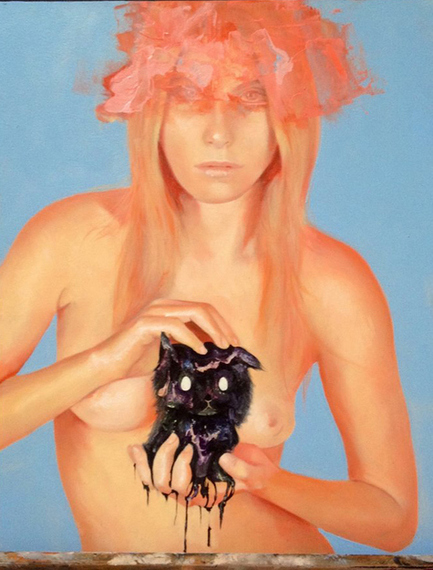

Honestly, I'm constantly reminding myself how precious and awesome being able to do this for a living is. I've had it taken away from me once already and I'm elated and relieved that I was able to get it back. I am beyond grateful for any gallery exhibit I participate in, any sale made, and any person and collector in life or via email/social media who tells me how they appreciate the work and how it's affected them. I never take any of it for granted.
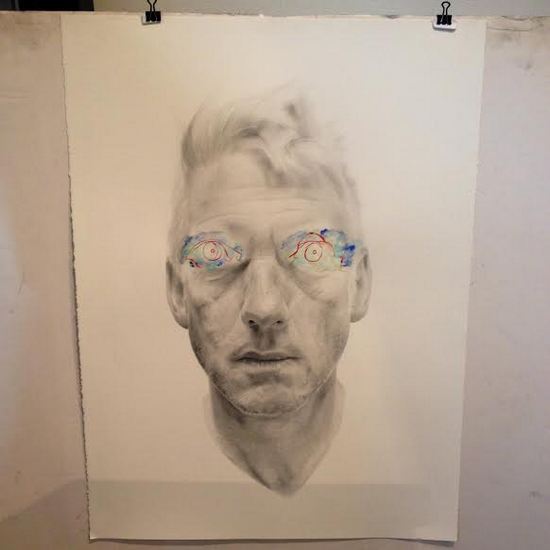
I'm happy to be participating in a few more shows this year out in the California: Smoke & Mirrors at Marcas Gallery, Tres Años at As Issued Gallery and I also am in a show at Flower Pepper Gallery. I also currently have a large piece on display at Gitana Rosa Gallery in Chelsea, NY. I will be locking myself away painting in time for Art Basel Miami. My studio is currently in the Art Center South Florida, in Miami Beach.
Some Current Exhibitions: SUGGESTIVISM: CHRONOLOGY, curated by Nathan Spoor
August 16 - September 6, 2014
Copro Gallery2525 Michigan Ave, T5
Santa Monica, CA 90904
SMOKE & MIRRORS
Marcas Contemporary Art
Opening: Sept. 6, 2014, 7 to 11PM
305 E. 4th St., #103 Santa Ana, CA 92701
↧



